The Restoration Stage It had two parts:


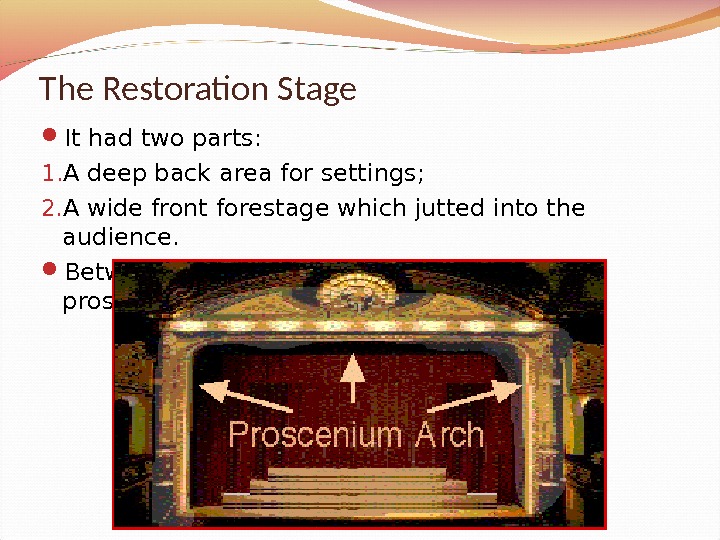
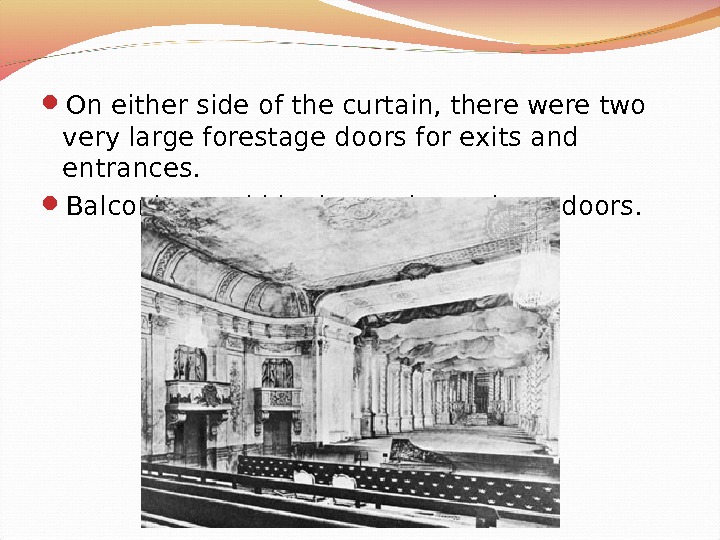
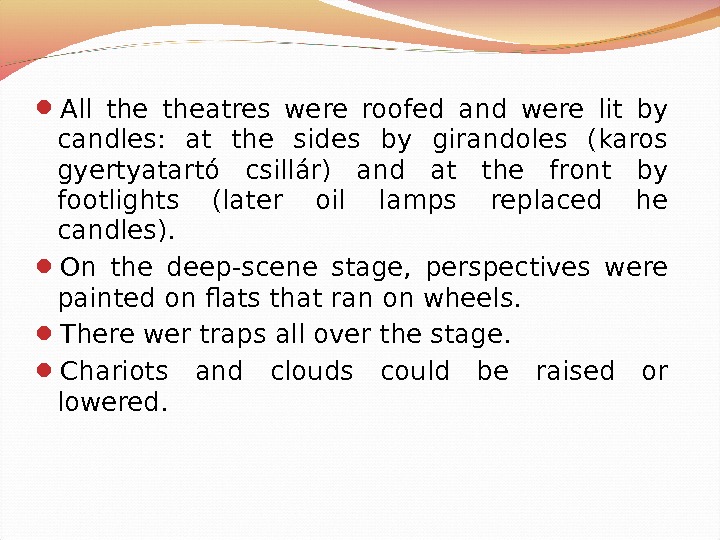
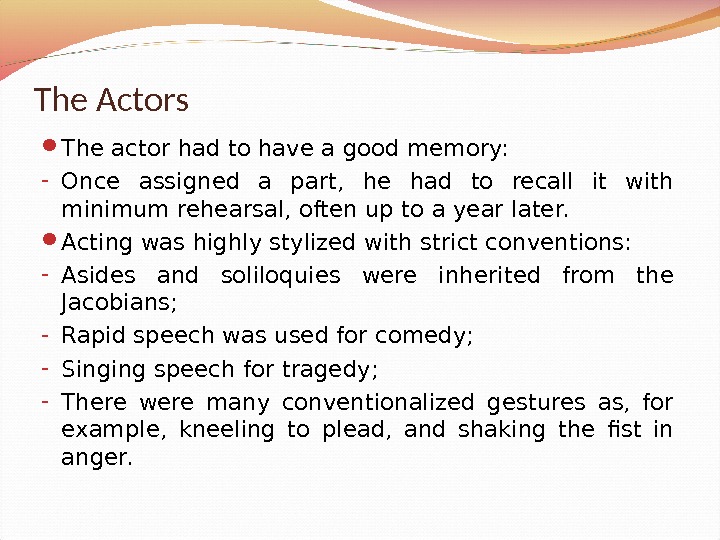
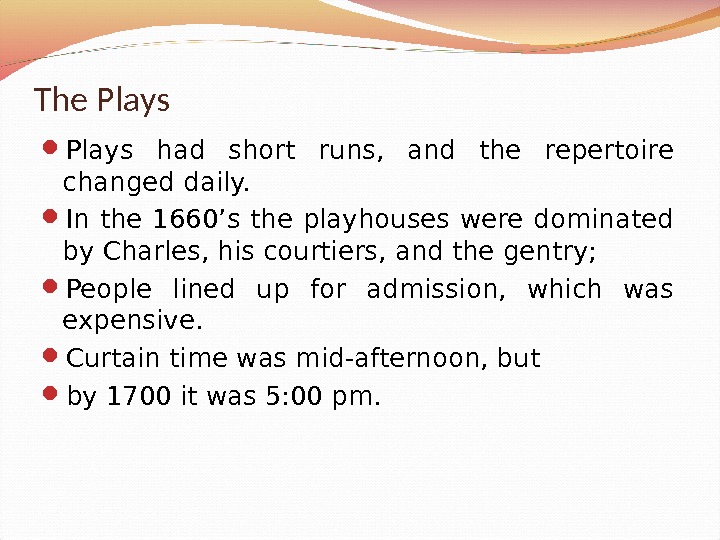
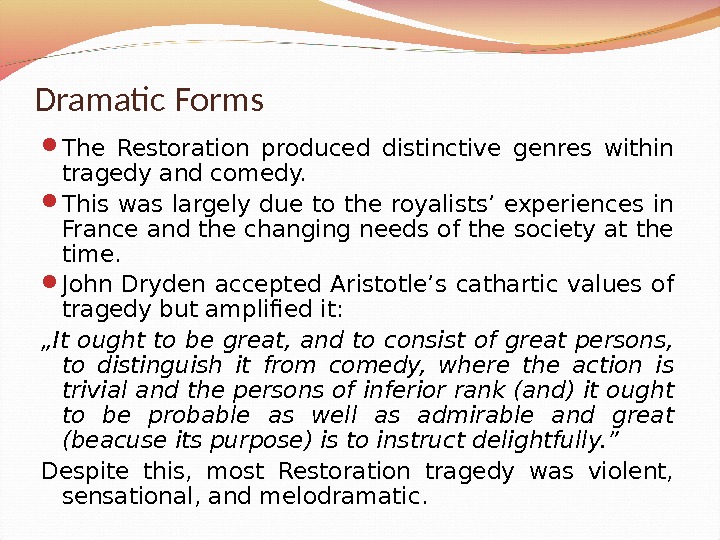
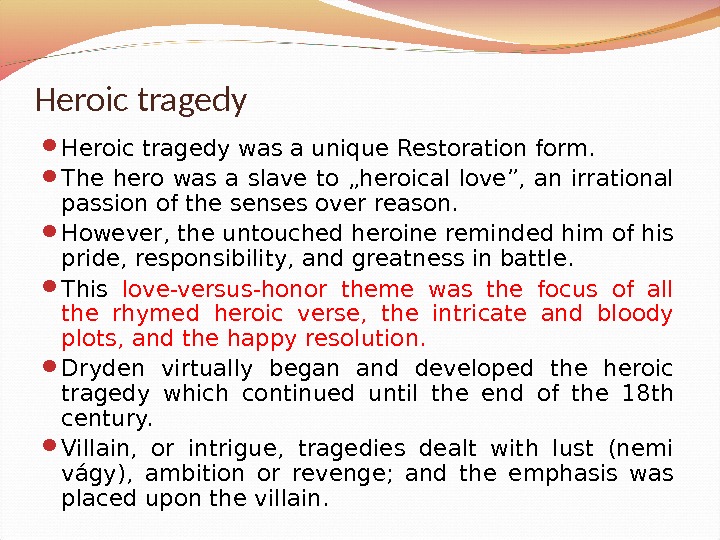
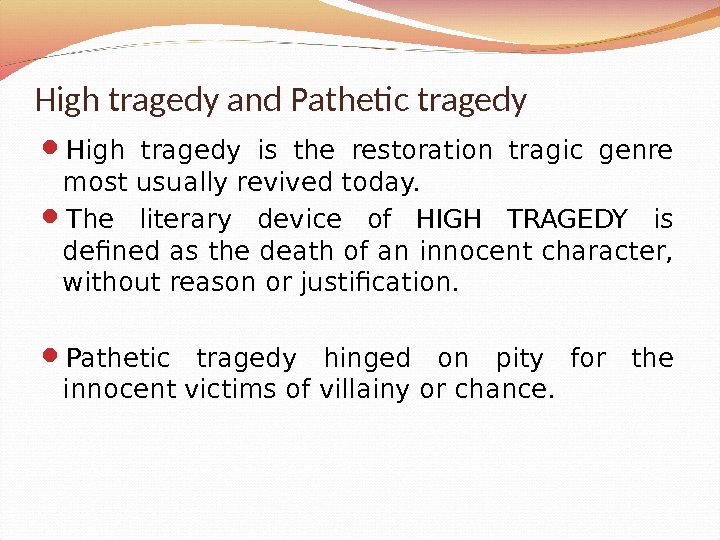
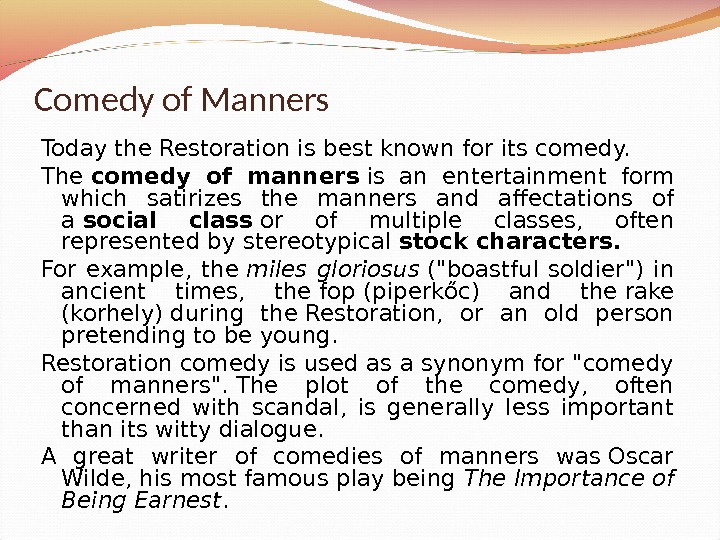

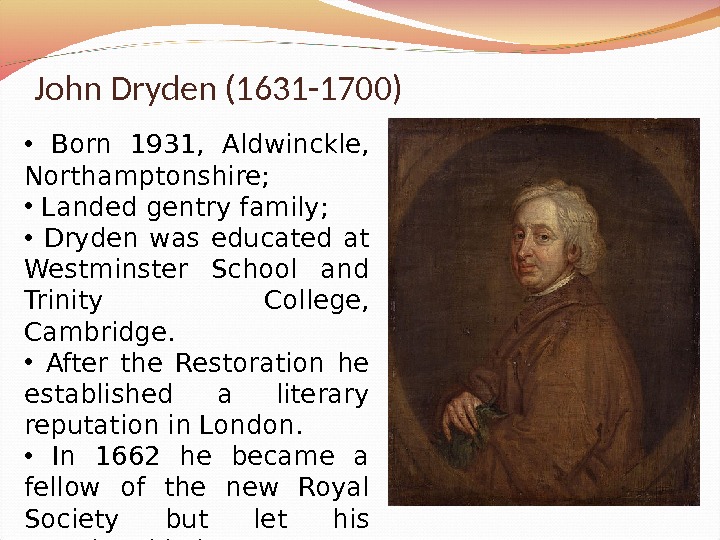
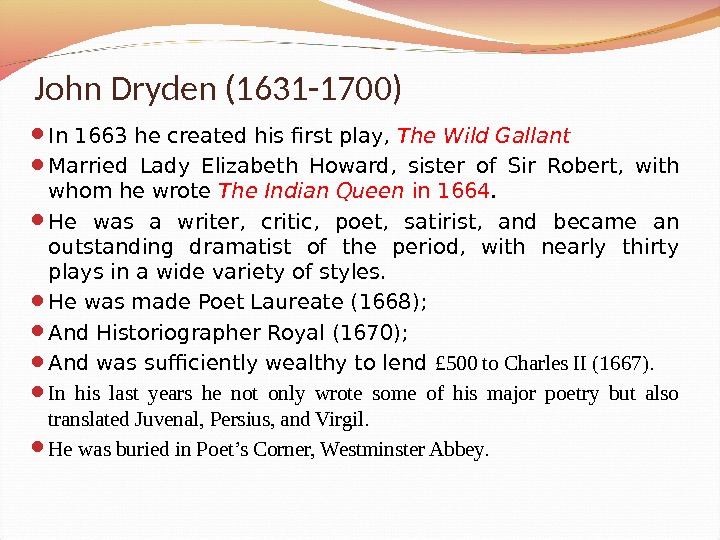
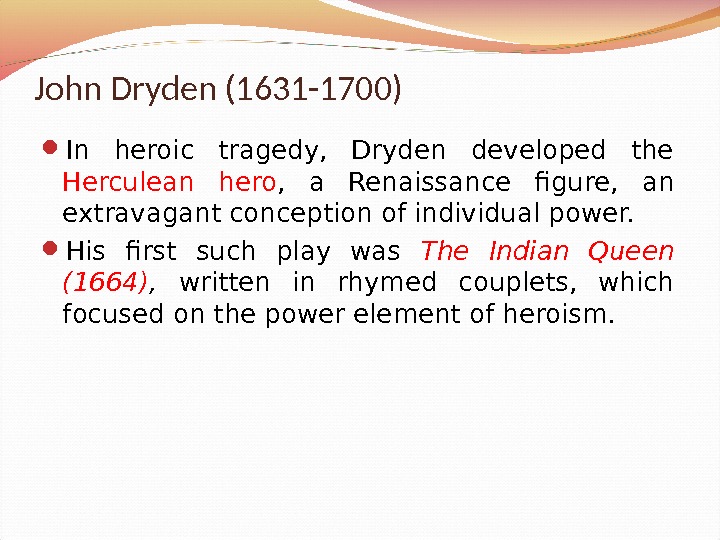
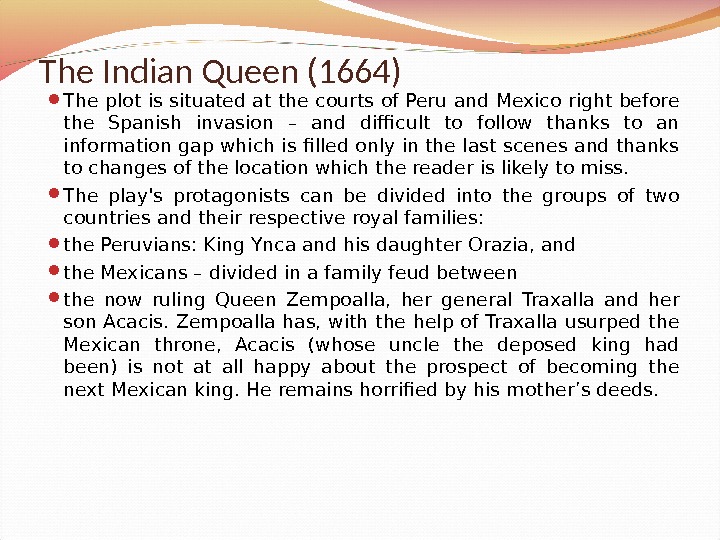
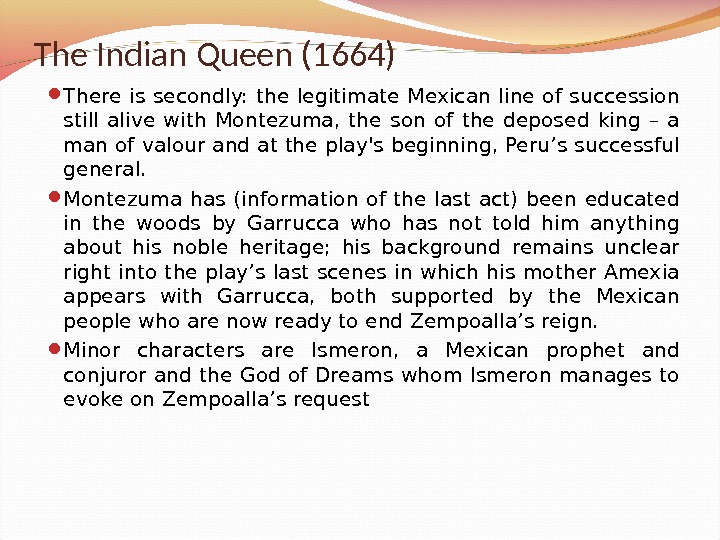
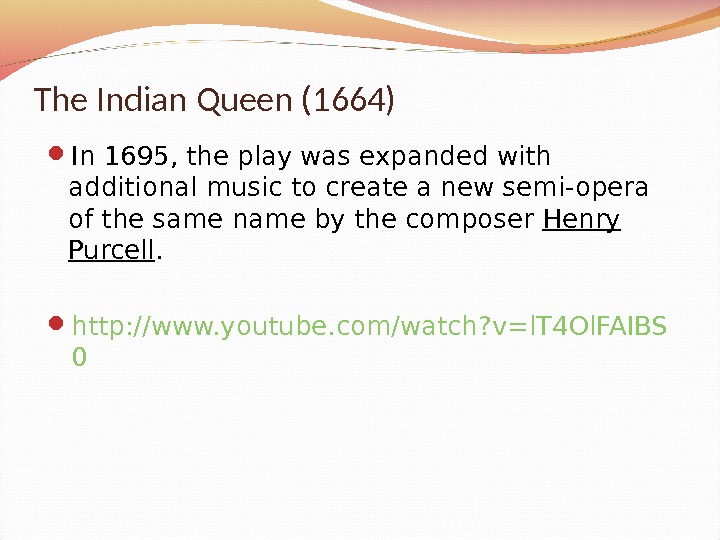
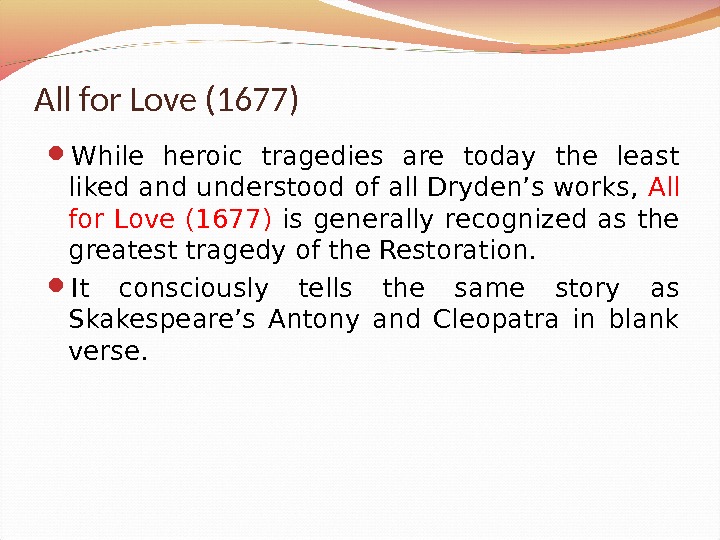
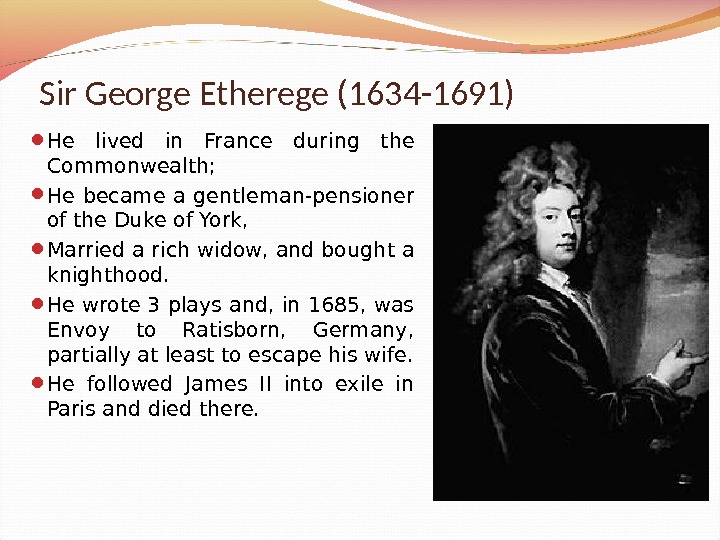
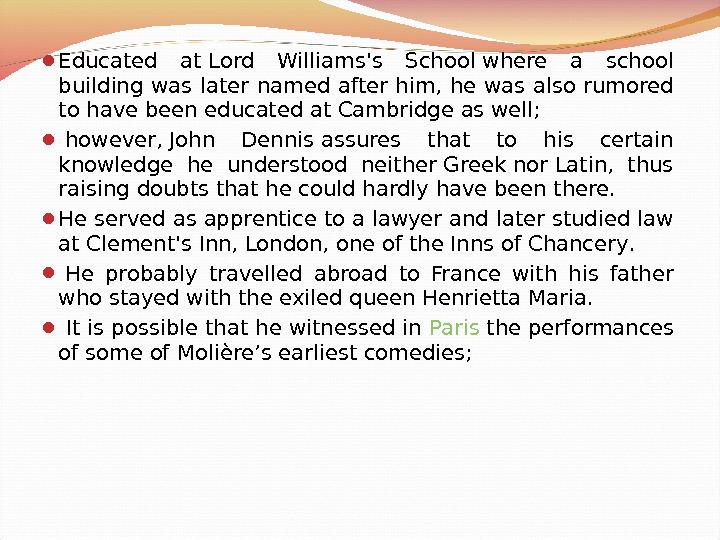
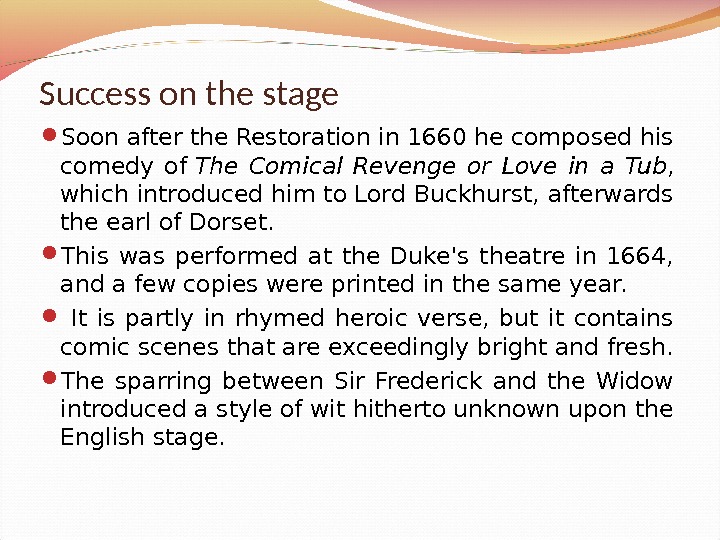
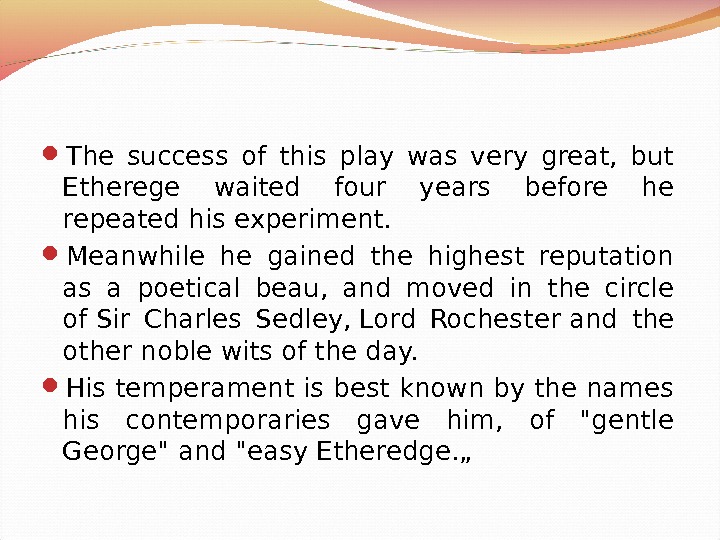


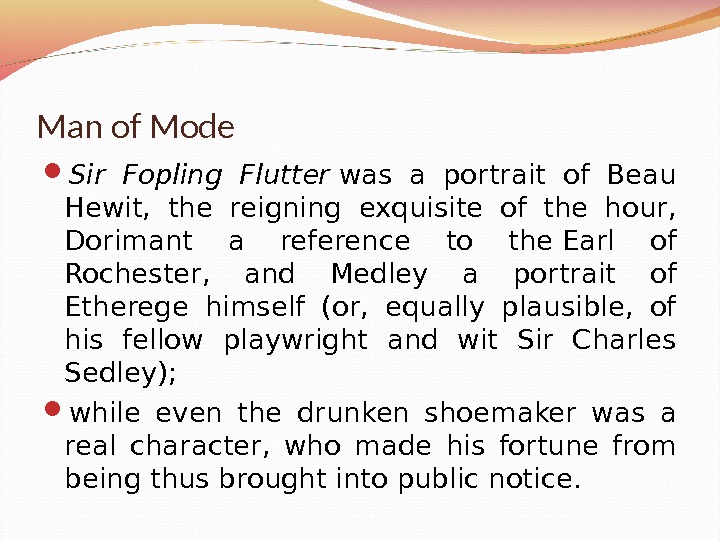
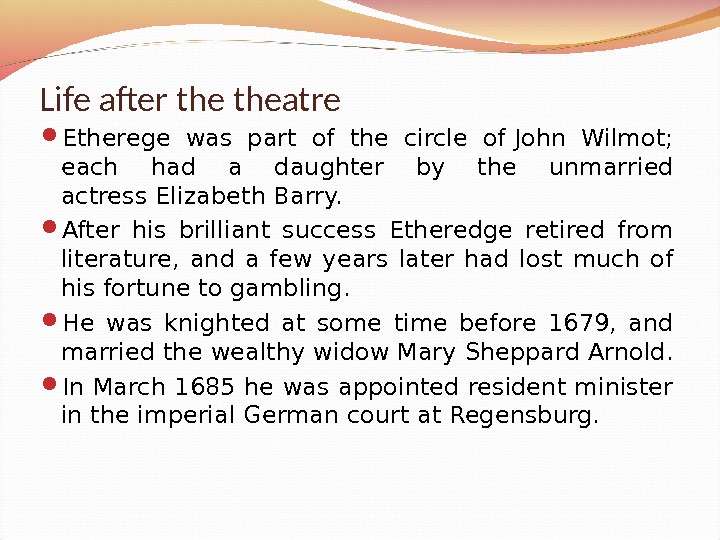

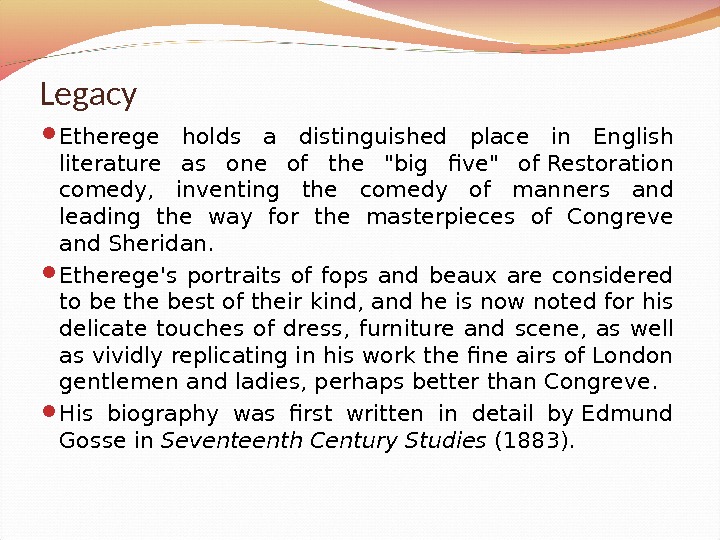
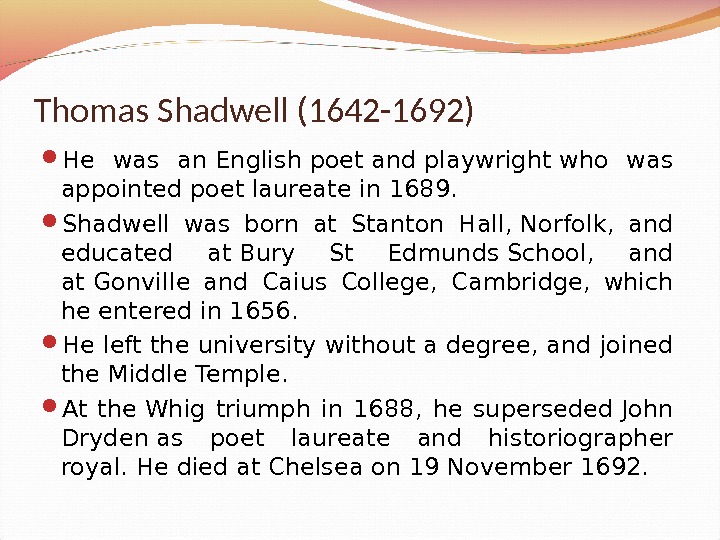
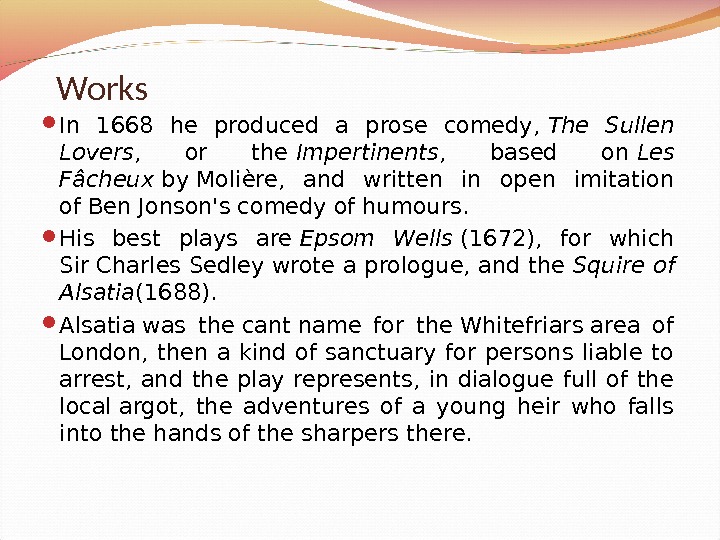
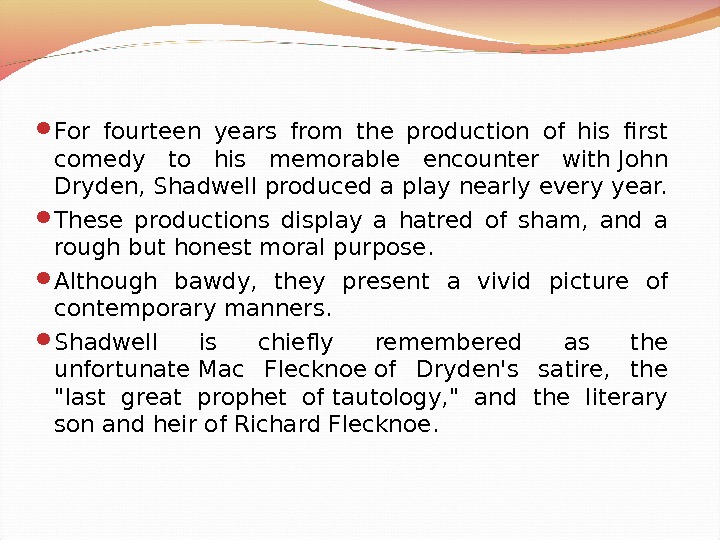
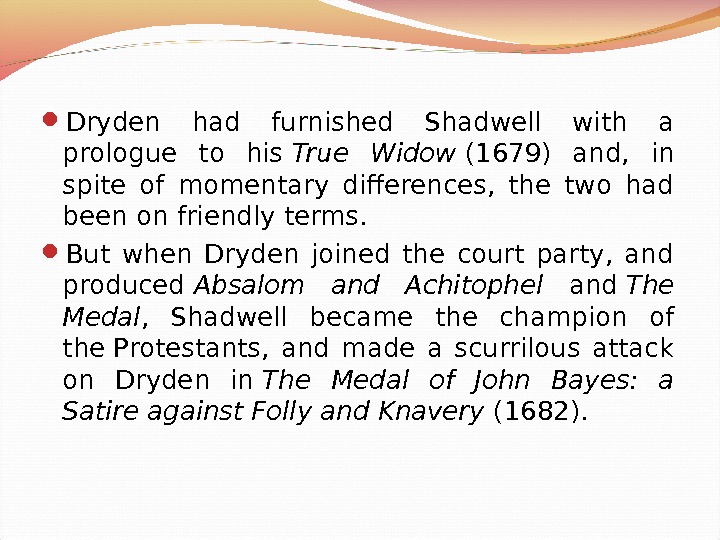
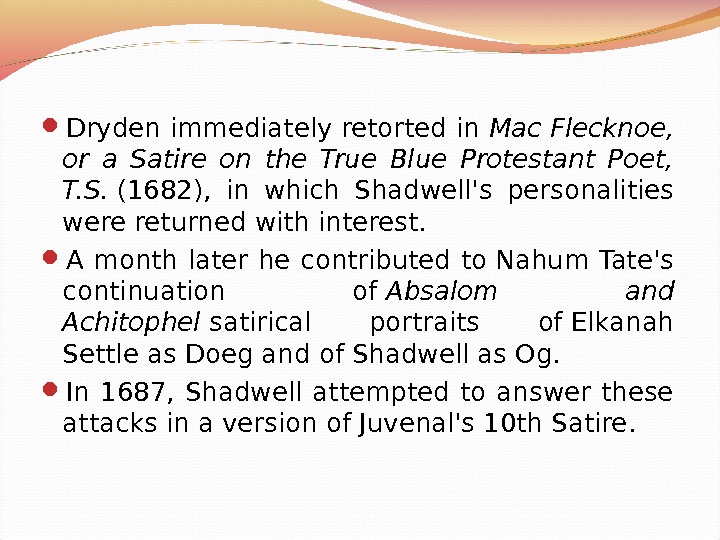
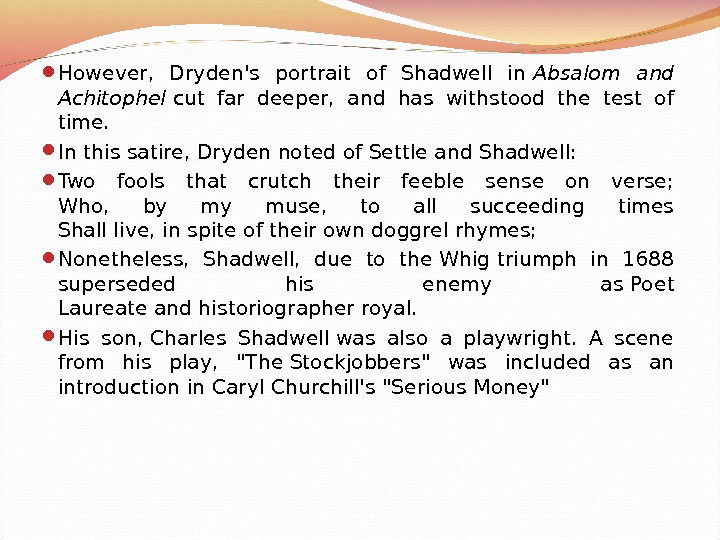
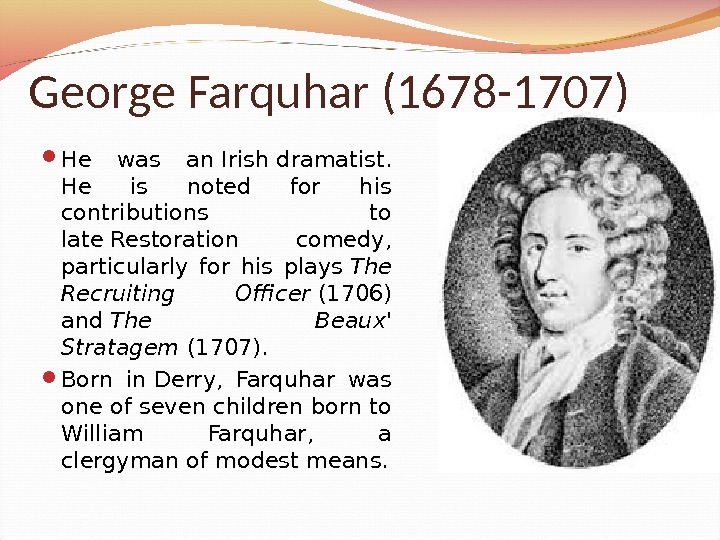
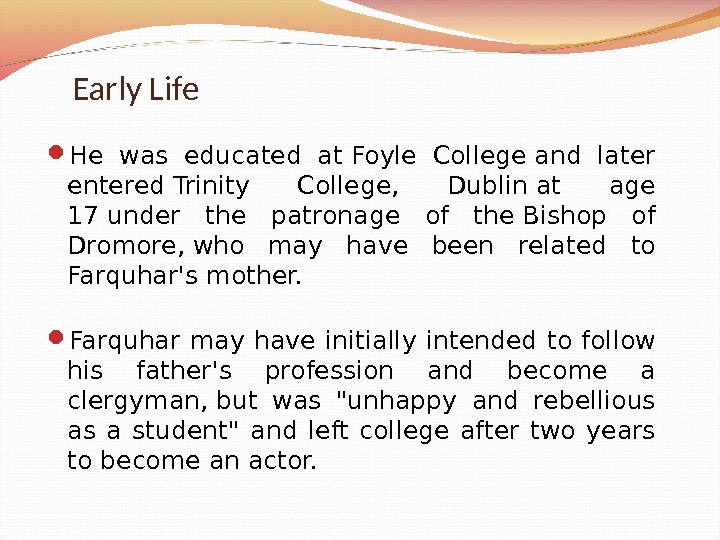
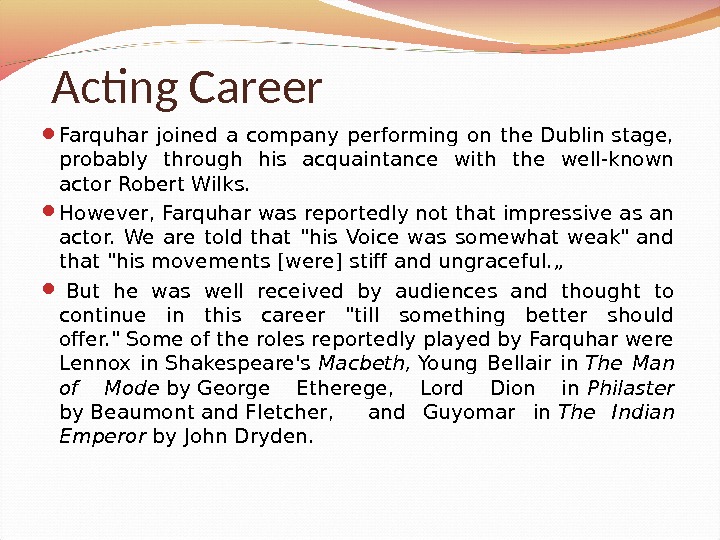
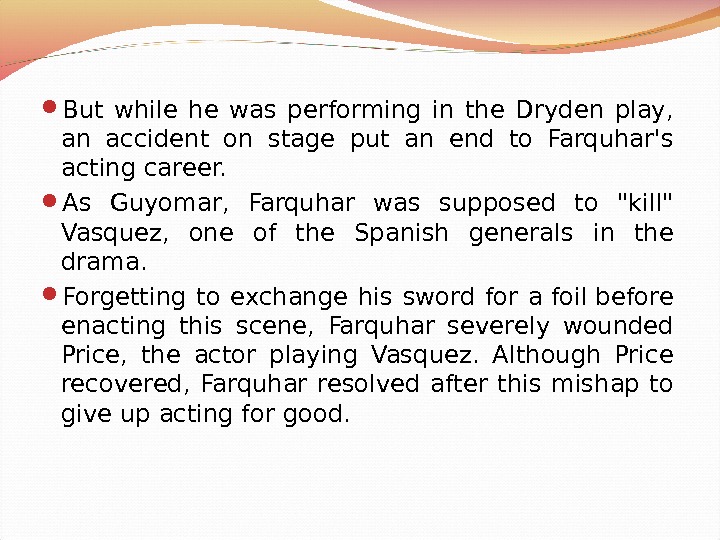
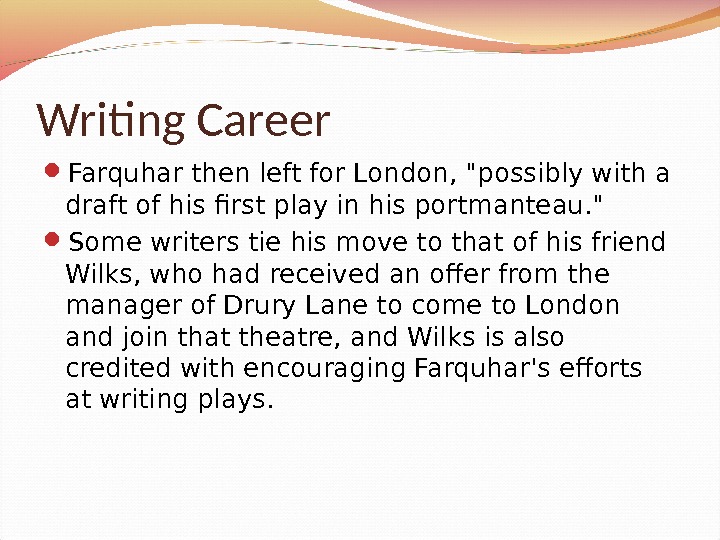


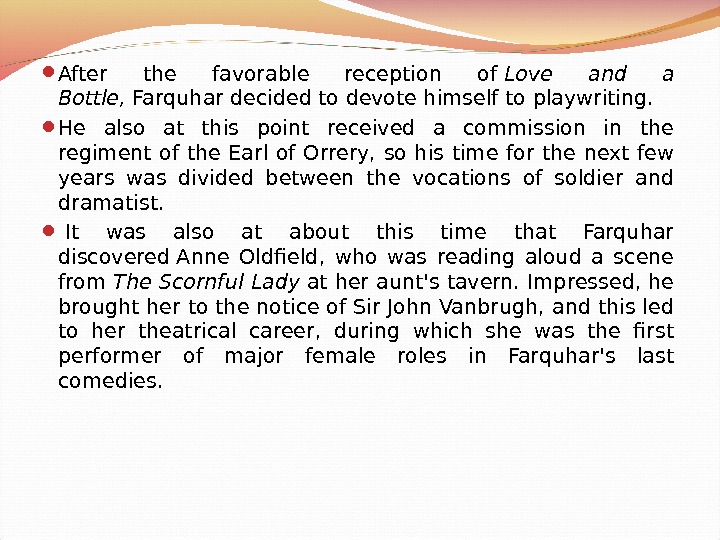
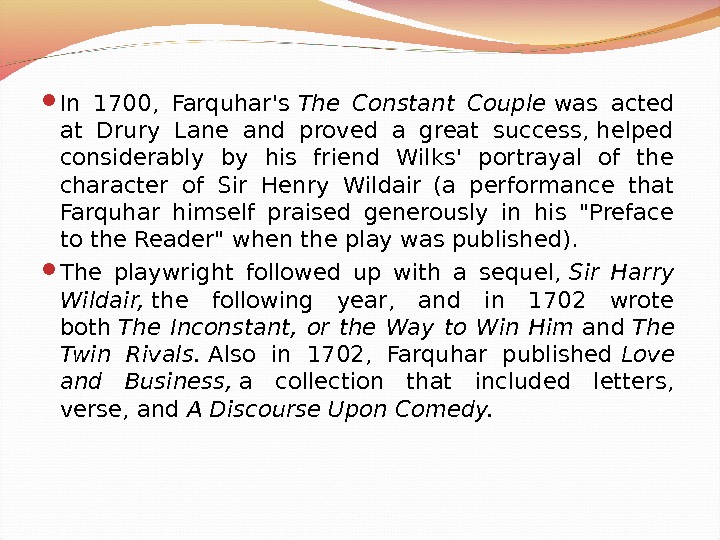
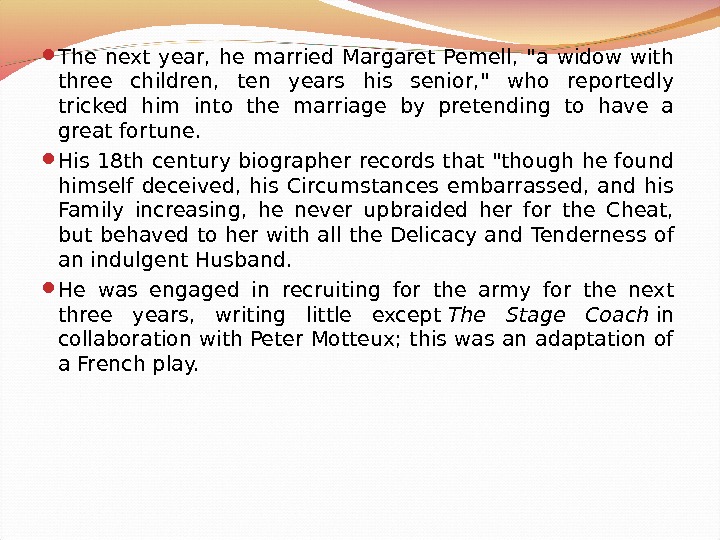
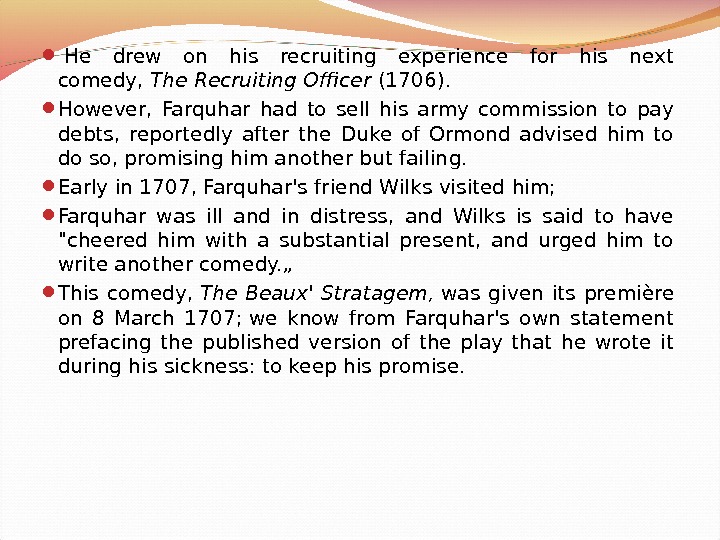
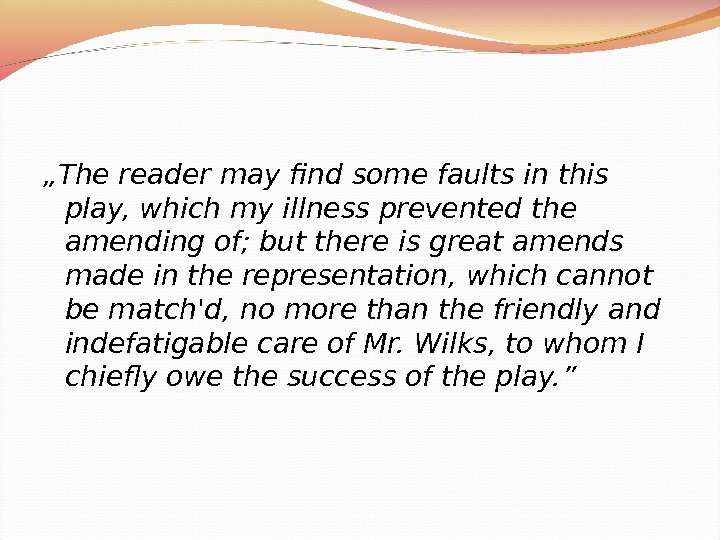
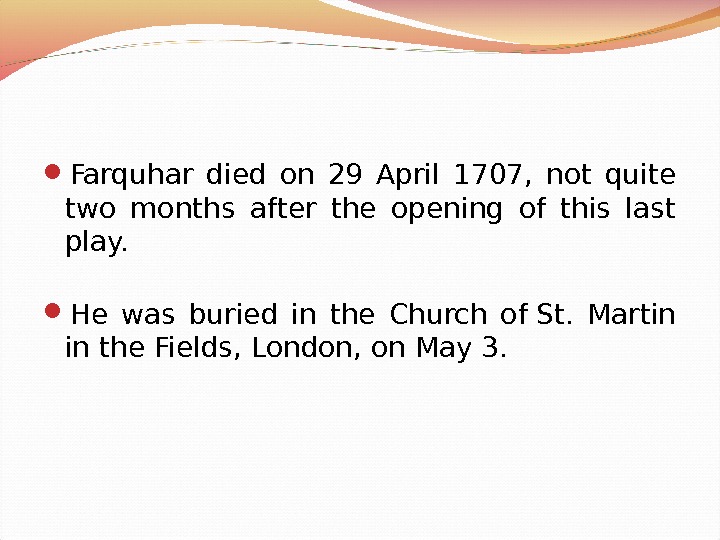
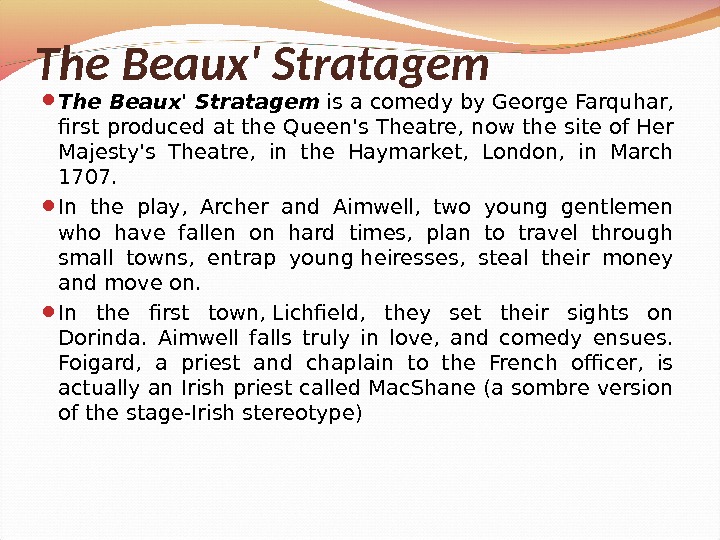
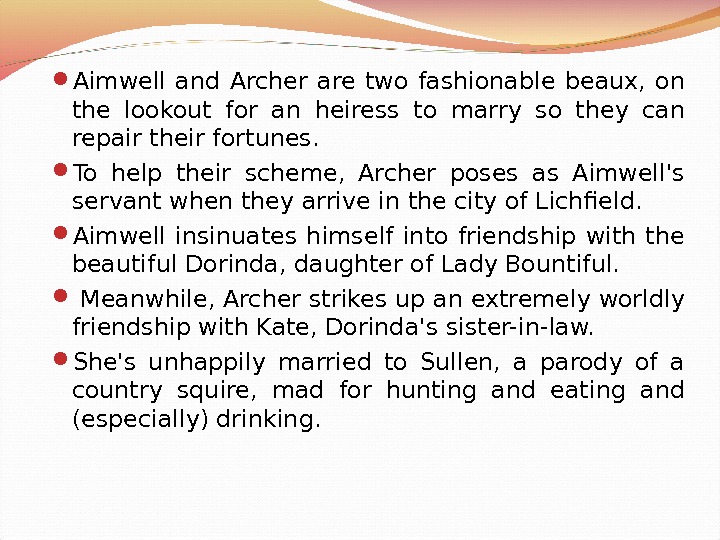
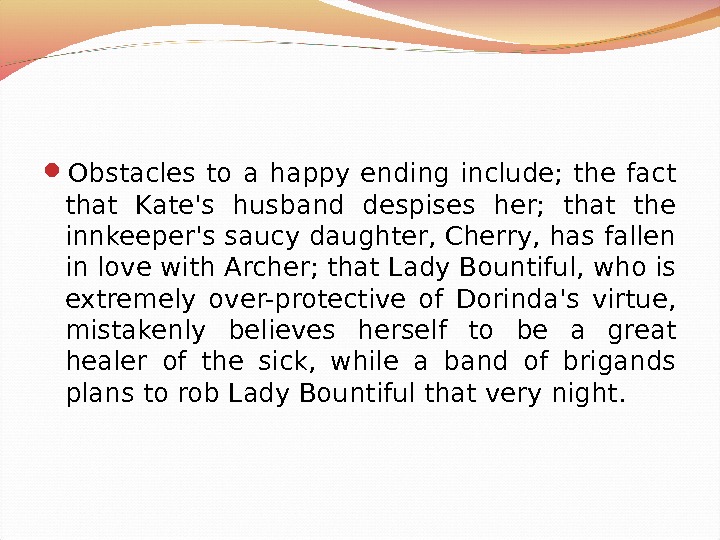



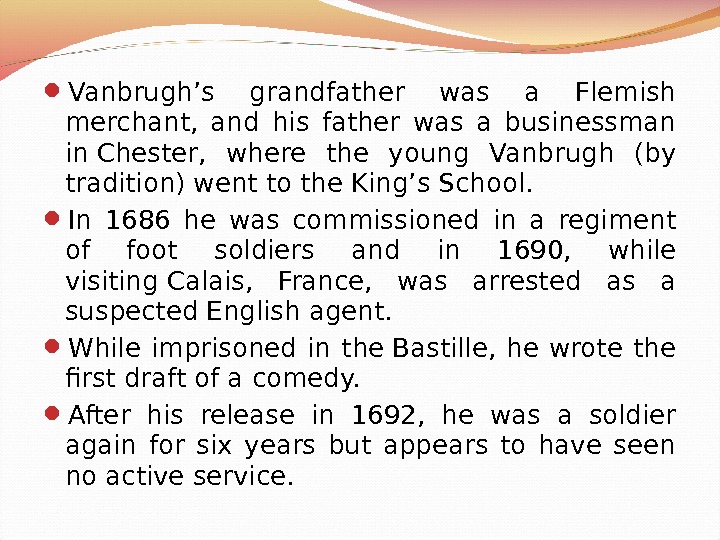

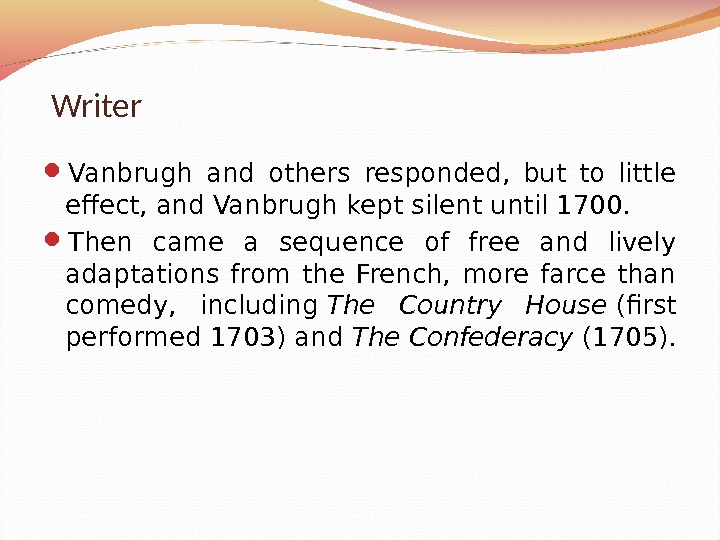
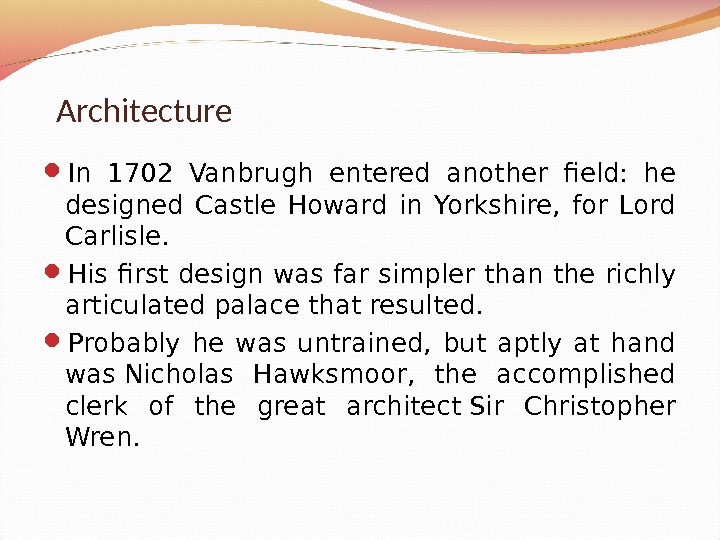
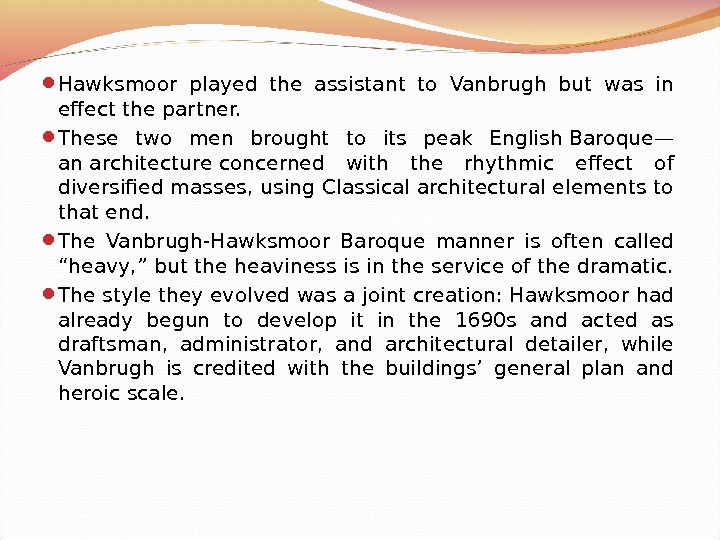
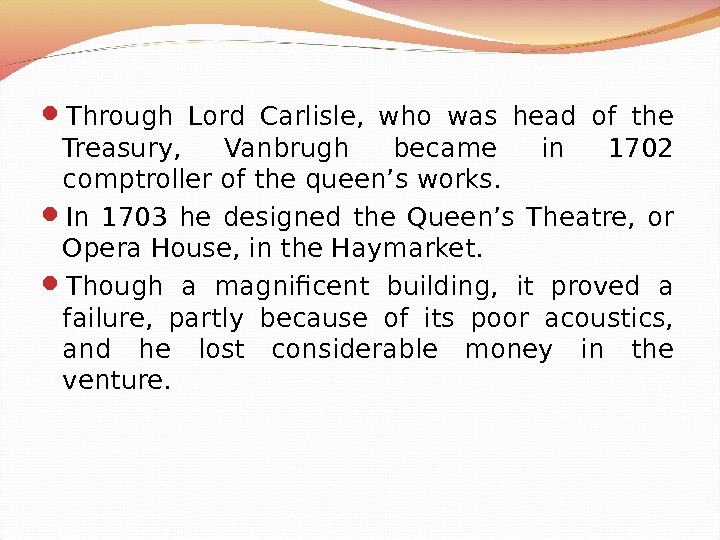
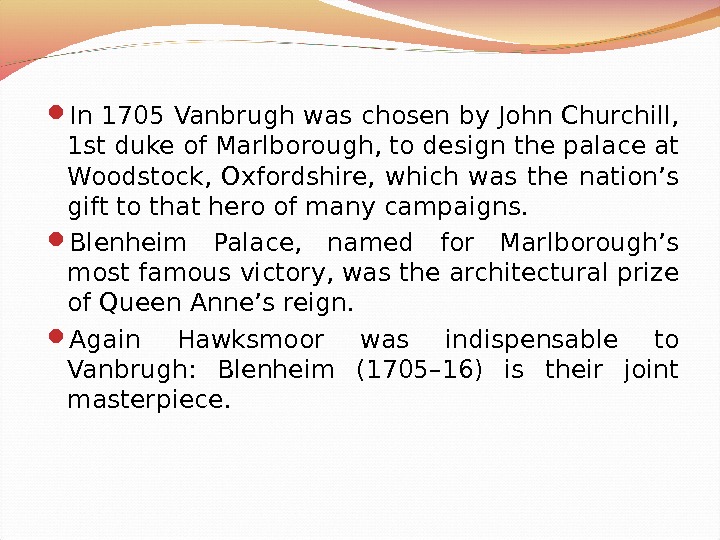
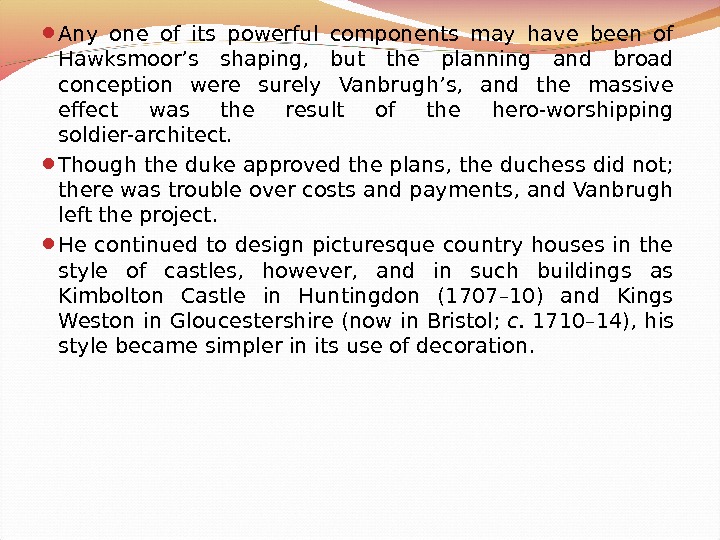
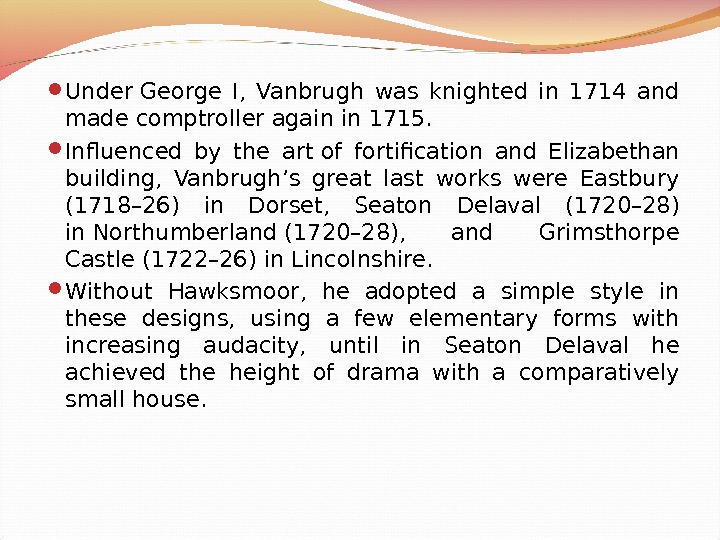
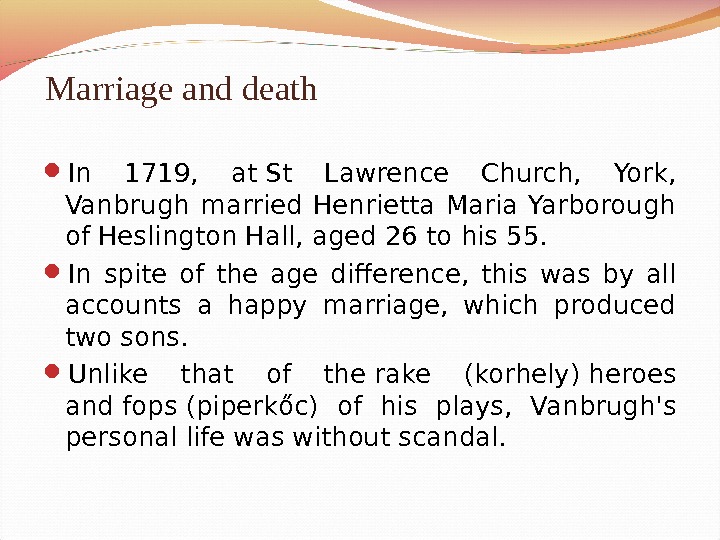

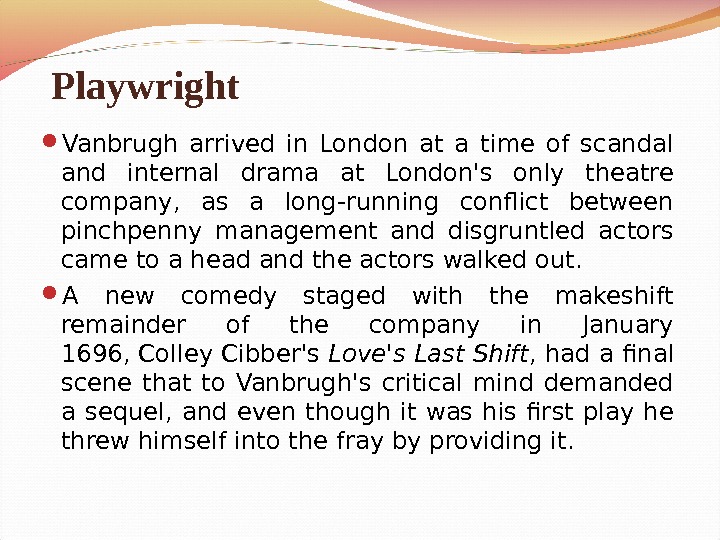
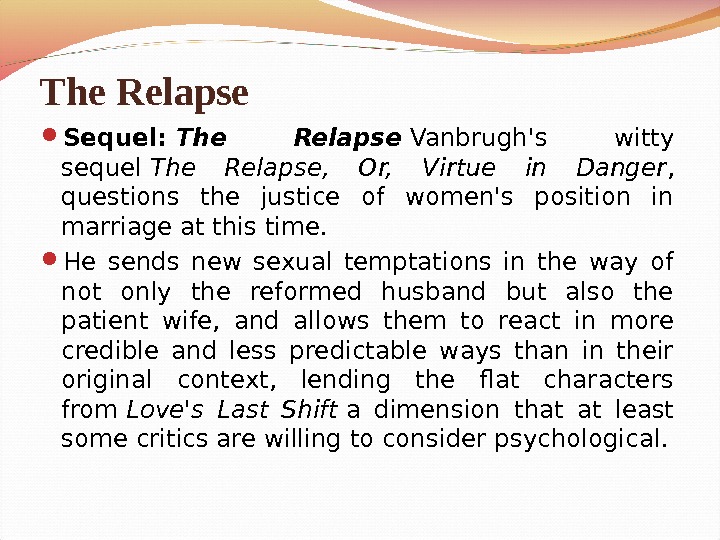
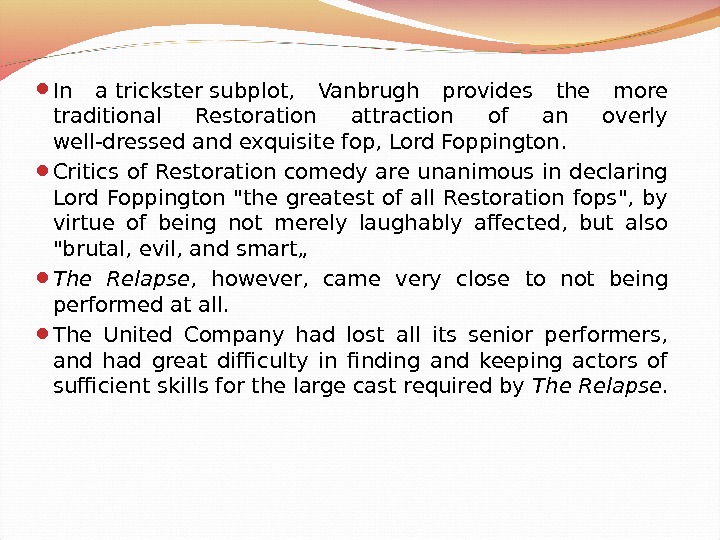
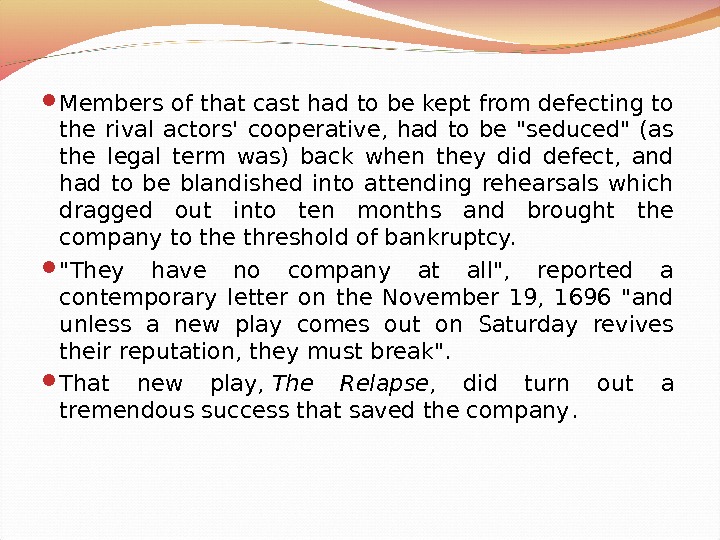
- Размер: 814 Кб
- Количество слайдов: 68
Описание презентации The Restoration Stage It had two parts: по слайдам

 The Restoration Stage It had two parts: 1. A deep back area for settings; 2. A wide front forestage which jutted into the audience. Between the two, a curtain hung from a proscenium arch.
The Restoration Stage It had two parts: 1. A deep back area for settings; 2. A wide front forestage which jutted into the audience. Between the two, a curtain hung from a proscenium arch.
 On either side of the curtain, there were two very large forestage doors for exits and entrances. Balconies could be hung above these doors.
On either side of the curtain, there were two very large forestage doors for exits and entrances. Balconies could be hung above these doors.
 All theatres were roofed and were lit by candles: at the sides by girandoles (karos gyertyatartó csillár) and at the front by footlights (later oil lamps replaced he candles). On the deep-scene stage, perspectives were painted on flats that ran on wheels. There wer traps all over the stage. Chariots and clouds could be raised or lowered.
All theatres were roofed and were lit by candles: at the sides by girandoles (karos gyertyatartó csillár) and at the front by footlights (later oil lamps replaced he candles). On the deep-scene stage, perspectives were painted on flats that ran on wheels. There wer traps all over the stage. Chariots and clouds could be raised or lowered.
 The Actors The actor had to have a good memory: — Once assigned a part, he had to recall it with minimum rehearsal, often up to a year later. Acting was highly stylized with strict conventions: — Asides and soliloquies were inherited from the Jacobians; — Rapid speech was used for comedy; — Singing speech for tragedy; — There were many conventionalized gestures as, for example, kneeling to plead, and shaking the fist in anger.
The Actors The actor had to have a good memory: — Once assigned a part, he had to recall it with minimum rehearsal, often up to a year later. Acting was highly stylized with strict conventions: — Asides and soliloquies were inherited from the Jacobians; — Rapid speech was used for comedy; — Singing speech for tragedy; — There were many conventionalized gestures as, for example, kneeling to plead, and shaking the fist in anger.
 The Plays had short runs, and the repertoire changed daily. In the 1660’s the playhouses were dominated by Charles, his courtiers, and the gentry; People lined up for admission, which was expensive. Curtain time was mid-afternoon, but by 1700 it was 5: 00 pm.
The Plays had short runs, and the repertoire changed daily. In the 1660’s the playhouses were dominated by Charles, his courtiers, and the gentry; People lined up for admission, which was expensive. Curtain time was mid-afternoon, but by 1700 it was 5: 00 pm.
 Dramatic Forms The Restoration produced distinctive genres within tragedy and comedy. This was largely due to the royalists’ experiences in France and the changing needs of the society at the time. John Dryden accepted Aristotle’s cathartic values of tragedy but amplified it: „ It ought to be great, and to consist of great persons, to distinguish it from comedy, where the action is trivial and the persons of inferior rank (and) it ought to be probable as well as admirable and great (beacuse its purpose) is to instruct delightfully. ” Despite this, most Restoration tragedy was violent, sensational, and melodramatic.
Dramatic Forms The Restoration produced distinctive genres within tragedy and comedy. This was largely due to the royalists’ experiences in France and the changing needs of the society at the time. John Dryden accepted Aristotle’s cathartic values of tragedy but amplified it: „ It ought to be great, and to consist of great persons, to distinguish it from comedy, where the action is trivial and the persons of inferior rank (and) it ought to be probable as well as admirable and great (beacuse its purpose) is to instruct delightfully. ” Despite this, most Restoration tragedy was violent, sensational, and melodramatic.
 Heroic tragedy was a unique Restoration form. The hero was a slave to „heroical love”, an irrational passion of the senses over reason. However, the untouched heroine reminded him of his pride, responsibility, and greatness in battle. This love-versus-honor theme was the focus of all the rhymed heroic verse, the intricate and bloody plots, and the happy res o lution. Dryden virtually began and developed the heroic tragedy which continued until the end of the 18 th century. Villain, or intrigue, tragedies dealt with lust (nemi vágy), ambition or revenge; and the emphasis was placed upon the villain.
Heroic tragedy was a unique Restoration form. The hero was a slave to „heroical love”, an irrational passion of the senses over reason. However, the untouched heroine reminded him of his pride, responsibility, and greatness in battle. This love-versus-honor theme was the focus of all the rhymed heroic verse, the intricate and bloody plots, and the happy res o lution. Dryden virtually began and developed the heroic tragedy which continued until the end of the 18 th century. Villain, or intrigue, tragedies dealt with lust (nemi vágy), ambition or revenge; and the emphasis was placed upon the villain.
 High tragedy and Pathetic tragedy High tragedy is the restoration tragic genre most usually revived today. The literary device of HIGH TRAGEDY is defined as the death of an innocent character, without reason or justification. Pathetic tragedy hinged on pity for the innocent victims of villainy or chance.
High tragedy and Pathetic tragedy High tragedy is the restoration tragic genre most usually revived today. The literary device of HIGH TRAGEDY is defined as the death of an innocent character, without reason or justification. Pathetic tragedy hinged on pity for the innocent victims of villainy or chance.
 Comedy of Manners Today the Restoration is best known for its comedy. The comedy of manners is an entertainment form which satirizes the manners and affectations of a social class or of multiple classes, often represented by stereotypical stock characters. For example, the miles gloriosus («boastful soldier») in ancient times, thefop (piperkőc) and therake (korhely) during the. Restoration, or an old person pretending to be young. Restoration comedyis used as a synonym for «comedy of manners». The plot of the comedy, often concerned with scandal, is generally less important than its witty dialogue. A great writer of comedies of manners was. Oscar Wilde, his most famous play being The Importance of Being Earnest.
Comedy of Manners Today the Restoration is best known for its comedy. The comedy of manners is an entertainment form which satirizes the manners and affectations of a social class or of multiple classes, often represented by stereotypical stock characters. For example, the miles gloriosus («boastful soldier») in ancient times, thefop (piperkőc) and therake (korhely) during the. Restoration, or an old person pretending to be young. Restoration comedyis used as a synonym for «comedy of manners». The plot of the comedy, often concerned with scandal, is generally less important than its witty dialogue. A great writer of comedies of manners was. Oscar Wilde, his most famous play being The Importance of Being Earnest.
 Opera emerged as a form in Britain. After D’Avenant’s The Siege of Rhodes, the first Restoration opera was a version of The Tempest by Dryden and Shadwell. Dryden and others championed „the English opera” where all the dialogue between the arias was spoken. Supported by the music of Henry Purcell, this held the stage.
Opera emerged as a form in Britain. After D’Avenant’s The Siege of Rhodes, the first Restoration opera was a version of The Tempest by Dryden and Shadwell. Dryden and others championed „the English opera” where all the dialogue between the arias was spoken. Supported by the music of Henry Purcell, this held the stage.
 John Dryden (1631 -1700) • Born 1931, Aldwinckle, Northamptonshire; • Landed gentry family; • Dryden was educated at Westminster School and Trinity College, Cambridge. • After the Restoration he established a literary reputation in London. • In 1662 he became a fellow of the new Royal Society but let his membership lapse.
John Dryden (1631 -1700) • Born 1931, Aldwinckle, Northamptonshire; • Landed gentry family; • Dryden was educated at Westminster School and Trinity College, Cambridge. • After the Restoration he established a literary reputation in London. • In 1662 he became a fellow of the new Royal Society but let his membership lapse.
 In 1663 he created his first play, The Wild Gallant Married Lady Elizabeth Howard, sister of Sir Robert, with whom he wrote The Indian Queen in 1664. He was a writer, critic, poet, satirist, and became an outstanding dramatist of the period, with nearly thirty plays in a wide variety of styles. He was made Poet Laureate (1668); And Historiographer Royal (1670); And was sufficiently wealthy to lend £ 500 to Charles II (1667). In his last years he not only wrote some of his major poetry but also translated Juvenal, Persius, and Virgil. He was buried in Poet’s Corner, Westminster Abbey. John Dryden (1631 -1700)
In 1663 he created his first play, The Wild Gallant Married Lady Elizabeth Howard, sister of Sir Robert, with whom he wrote The Indian Queen in 1664. He was a writer, critic, poet, satirist, and became an outstanding dramatist of the period, with nearly thirty plays in a wide variety of styles. He was made Poet Laureate (1668); And Historiographer Royal (1670); And was sufficiently wealthy to lend £ 500 to Charles II (1667). In his last years he not only wrote some of his major poetry but also translated Juvenal, Persius, and Virgil. He was buried in Poet’s Corner, Westminster Abbey. John Dryden (1631 -1700)
 In heroic tragedy, Dryden developed the Herculean hero , a Renaissance figure, an extravagant conception of individual power. His first such play was The Indian Queen (1664) , written in rhymed couplets, which focused on the power element of heroism. John Dryden (1631 -1700)
In heroic tragedy, Dryden developed the Herculean hero , a Renaissance figure, an extravagant conception of individual power. His first such play was The Indian Queen (1664) , written in rhymed couplets, which focused on the power element of heroism. John Dryden (1631 -1700)
 The plot is situated at the courts of Peru and Mexico right before the Spanish invasion – and difficult to follow thanks to an information gap which is filled only in the last scenes and thanks to changes of the location which the reader is likely to miss. The play’s protagonists can be divided into the groups of two countries and their respective royal families: the Peruvians: King Ynca and his daughter Orazia, and the Mexicans – divided in a family feud between the now ruling Queen Zempoalla, her general Traxalla and her son Acacis. Zempoalla has, with the help of Traxalla usurped the Mexican throne, Acacis (whose uncle the deposed king had been) is not at all happy about the prospect of becoming the next Mexican king. He remains horrified by his mother’s deeds. The Indian Queen (1664)
The plot is situated at the courts of Peru and Mexico right before the Spanish invasion – and difficult to follow thanks to an information gap which is filled only in the last scenes and thanks to changes of the location which the reader is likely to miss. The play’s protagonists can be divided into the groups of two countries and their respective royal families: the Peruvians: King Ynca and his daughter Orazia, and the Mexicans – divided in a family feud between the now ruling Queen Zempoalla, her general Traxalla and her son Acacis. Zempoalla has, with the help of Traxalla usurped the Mexican throne, Acacis (whose uncle the deposed king had been) is not at all happy about the prospect of becoming the next Mexican king. He remains horrified by his mother’s deeds. The Indian Queen (1664)
 There is secondly: the legitimate Mexican line of succession still alive with Montezuma, the son of the deposed king – a man of valour and at the play’s beginning, Peru’s successful general. Montezuma has (information of the last act) been educated in the woods by Garrucca who has not told him anything about his noble heritage; his background remains unclear right into the play’s last scenes in which his mother Amexia appears with Garrucca, both supported by the Mexican people who are now ready to end Zempoalla’s reign. Minor characters are Ismeron, a Mexican prophet and conjuror and the God of Dreams whom Ismeron manages to evoke on Zempoalla’s request. The Indian Queen (1664)
There is secondly: the legitimate Mexican line of succession still alive with Montezuma, the son of the deposed king – a man of valour and at the play’s beginning, Peru’s successful general. Montezuma has (information of the last act) been educated in the woods by Garrucca who has not told him anything about his noble heritage; his background remains unclear right into the play’s last scenes in which his mother Amexia appears with Garrucca, both supported by the Mexican people who are now ready to end Zempoalla’s reign. Minor characters are Ismeron, a Mexican prophet and conjuror and the God of Dreams whom Ismeron manages to evoke on Zempoalla’s request. The Indian Queen (1664)
 In 1695, the play was expanded with additional music to create anew semi-opera of the same nameby the composer Henry Purcell. http: //www. youtube. com/watch? v=l. T 4 Ol. FAIBS 0 The Indian Queen (1664)
In 1695, the play was expanded with additional music to create anew semi-opera of the same nameby the composer Henry Purcell. http: //www. youtube. com/watch? v=l. T 4 Ol. FAIBS 0 The Indian Queen (1664)
 While heroic tragedies are today the least liked and understood of all Dryden’s works, All for Love (1677) is generally recognized as the greatest tragedy of the Restoration. It consciously tells the same story as Skakespeare’s Antony and Cleopatra in blank verse. All for Love (1677)
While heroic tragedies are today the least liked and understood of all Dryden’s works, All for Love (1677) is generally recognized as the greatest tragedy of the Restoration. It consciously tells the same story as Skakespeare’s Antony and Cleopatra in blank verse. All for Love (1677)
 He lived in France during the Commonwealth; He became a gentleman-pensioner of the Duke of York, Married a rich widow, and bought a knighthood. He wrote 3 plays and, in 1685, was Envoy to Ratisborn, Germany, partially at least to escape his wife. He followed James II into exile in Paris and died there. Sir George Etherege (1634 -1691)
He lived in France during the Commonwealth; He became a gentleman-pensioner of the Duke of York, Married a rich widow, and bought a knighthood. He wrote 3 plays and, in 1685, was Envoy to Ratisborn, Germany, partially at least to escape his wife. He followed James II into exile in Paris and died there. Sir George Etherege (1634 -1691)
 Educated at. Lord Williams’s Schoolwhere a school building was later named after him, he was also rumored to have been educated at Cambridge as well; however, John Dennisassures that to his certain knowledge he understood neither. Greeknor. Latin, thus raising doubts that he could hardly have been there. He served as apprentice to a lawyer and later studied law at Clement’s Inn, London, one of the. Inns of Chancery. He probably travelled abroad to France with his father who stayed with the exiled queen Henrietta Maria. It is possible that he witnessed in Paris the performances of some of. Molière ’s earliest comedies;
Educated at. Lord Williams’s Schoolwhere a school building was later named after him, he was also rumored to have been educated at Cambridge as well; however, John Dennisassures that to his certain knowledge he understood neither. Greeknor. Latin, thus raising doubts that he could hardly have been there. He served as apprentice to a lawyer and later studied law at Clement’s Inn, London, one of the. Inns of Chancery. He probably travelled abroad to France with his father who stayed with the exiled queen Henrietta Maria. It is possible that he witnessed in Paris the performances of some of. Molière ’s earliest comedies;
 Success on the stage Soon after the. Restorationin 1660 he composed his comedy of The Comical Revenge or Love in a Tub , which introduced him to. Lord Buckhurst, afterwards the earl of. Dorset. This was performed at the Duke’s theatre in 1664, and a few copies were printed in the same year. It is partly in rhymed heroic verse, but it contains comic scenes that are exceedingly bright and fresh. The sparring between Sir Frederick and the Widow introduced a style of wit hitherto unknown upon the English stage.
Success on the stage Soon after the. Restorationin 1660 he composed his comedy of The Comical Revenge or Love in a Tub , which introduced him to. Lord Buckhurst, afterwards the earl of. Dorset. This was performed at the Duke’s theatre in 1664, and a few copies were printed in the same year. It is partly in rhymed heroic verse, but it contains comic scenes that are exceedingly bright and fresh. The sparring between Sir Frederick and the Widow introduced a style of wit hitherto unknown upon the English stage.
 The success of this play was very great, but Etherege waited four years before he repeated his experiment. Meanwhile he gained the highest reputation as a poetical beau, and moved in the circle of. Sir Charles Sedley, Lord Rochest e rand the other noble wits of the day. His temperament is best known by the names his contemporaries gave him, of «gentle George» and «easy Etheredge. „
The success of this play was very great, but Etherege waited four years before he repeated his experiment. Meanwhile he gained the highest reputation as a poetical beau, and moved in the circle of. Sir Charles Sedley, Lord Rochest e rand the other noble wits of the day. His temperament is best known by the names his contemporaries gave him, of «gentle George» and «easy Etheredge. „
 In 1668 he brought out She would if she could , a comedy full of action, wit and spirit, although by some thought to be frivolous and immoral. But in this play Etherege first shows himself a new power in literature. We move in an airy and fantastic world, where flirtation is the only serious business of life. At this time Etherege was living a life no less frivolous and unprincipled than those of his Courtals and Freemans.
In 1668 he brought out She would if she could , a comedy full of action, wit and spirit, although by some thought to be frivolous and immoral. But in this play Etherege first shows himself a new power in literature. We move in an airy and fantastic world, where flirtation is the only serious business of life. At this time Etherege was living a life no less frivolous and unprincipled than those of his Courtals and Freemans.
 Between 1668 and 1671 Etherege went to. Constantinopleas secretary of the English ambassador Sir. Daniel Harvey. After a silence of eight years, he came forward with one more play, which would be his last. The Man of Mode or, Sir Fopling Flutter , widely considered the best comedy of manners written in England before the days of. Congreve, was acted and printed in 1676, and enjoyed an unbounded success. This may be attributed to the belief that it satirises, or at least references, well known contemporaries of. London. Man of Mode
Between 1668 and 1671 Etherege went to. Constantinopleas secretary of the English ambassador Sir. Daniel Harvey. After a silence of eight years, he came forward with one more play, which would be his last. The Man of Mode or, Sir Fopling Flutter , widely considered the best comedy of manners written in England before the days of. Congreve, was acted and printed in 1676, and enjoyed an unbounded success. This may be attributed to the belief that it satirises, or at least references, well known contemporaries of. London. Man of Mode
 Man of Mode Sir Fopling Flutter was a portrait of Beau Hewit, the reigning exquisite of the hour, Dorimant a reference to the. Earl of Rochester, and Medley a portrait of Etherege himself (or, equally plausible, of his fellow playwright and wit Sir Charles Sedley); while even the drunken shoemaker was a real character, who made his fortune from being thus brought into public notice.
Man of Mode Sir Fopling Flutter was a portrait of Beau Hewit, the reigning exquisite of the hour, Dorimant a reference to the. Earl of Rochester, and Medley a portrait of Etherege himself (or, equally plausible, of his fellow playwright and wit Sir Charles Sedley); while even the drunken shoemaker was a real character, who made his fortune from being thus brought into public notice.
 Life after theatre Etherege was part of the circle of. John Wilmot; each had a daughter by the unmarried actress. Elizabeth Barry. After his brilliant success Etheredge retired from literature, and a few years later had lost much of his fortune to gambling. He was knighted at some time before 1679, and married the wealthy widow. Mary Sheppard Arnold. In March 1685 he was appointed resident minister in the imperial German court at. Regensburg.
Life after theatre Etherege was part of the circle of. John Wilmot; each had a daughter by the unmarried actress. Elizabeth Barry. After his brilliant success Etheredge retired from literature, and a few years later had lost much of his fortune to gambling. He was knighted at some time before 1679, and married the wealthy widow. Mary Sheppard Arnold. In March 1685 he was appointed resident minister in the imperial German court at. Regensburg.
 After three and a half-year’s residence and after the. Glorious Revolution, he left for Paris to join. James II in exile. His manuscript despatches are preserved in the. British Museum, where they were discovered and described by Gosse in 1881; He died in Paris, probably in 1691, for. Narcissus Luttrellnotes in February 1692 that Sir George Etherege, the late King James’ ambassador to. Vienna, had died recently in Paris.
After three and a half-year’s residence and after the. Glorious Revolution, he left for Paris to join. James II in exile. His manuscript despatches are preserved in the. British Museum, where they were discovered and described by Gosse in 1881; He died in Paris, probably in 1691, for. Narcissus Luttrellnotes in February 1692 that Sir George Etherege, the late King James’ ambassador to. Vienna, had died recently in Paris.
 Legacy Etherege holds a distinguished place in English literature as one of the «big five» of. Restoration comedy, inventing the comedy of manners and leading the way for the masterpieces of Congreve and. Sheridan. Etherege’s portraits of fops and beaux are considered to be the best of their kind, and he is now noted for his delicate touches of dress, furniture and scene, as well as vividly replicating in his work the fine airs of London gentlemen and ladies, perhaps better than Congreve. His biography was first written in detail by. Edmund Gossein Seventeenth Century Studies (1883).
Legacy Etherege holds a distinguished place in English literature as one of the «big five» of. Restoration comedy, inventing the comedy of manners and leading the way for the masterpieces of Congreve and. Sheridan. Etherege’s portraits of fops and beaux are considered to be the best of their kind, and he is now noted for his delicate touches of dress, furniture and scene, as well as vividly replicating in his work the fine airs of London gentlemen and ladies, perhaps better than Congreve. His biography was first written in detail by. Edmund Gossein Seventeenth Century Studies (1883).
 Thomas Shadwell (1642 -1692) He was an. Englishpoetandplaywrightwho was appointedpoet laureatein 1689. Shadwell was born at Stanton Hall, Norfolk, and educated at. Bury St Edmunds. School, and at. Gonvil le and Caius College, Cambridge, which he entered in 1656. He left the university without a degree, and joined the. Middle Temple. At the. Whig triumph in 1688, he superseded. John Drydenas poet laureate and historiographer royal. He died at Chelsea on 19 November 1692.
Thomas Shadwell (1642 -1692) He was an. Englishpoetandplaywrightwho was appointedpoet laureatein 1689. Shadwell was born at Stanton Hall, Norfolk, and educated at. Bury St Edmunds. School, and at. Gonvil le and Caius College, Cambridge, which he entered in 1656. He left the university without a degree, and joined the. Middle Temple. At the. Whig triumph in 1688, he superseded. John Drydenas poet laureate and historiographer royal. He died at Chelsea on 19 November 1692.
 Works In 1668 he produced a prose comedy, The Sullen Lovers , or the Impertinents , based on Les Fâcheux by. Molière, and written in open imitation of. Ben Jonson’s comedy of humours. His best plays are Epsom Wells (1672), for which Sir. Charles Sedleywrote a prologue, and the Squire of Alsatia (1688). Alsatiawas thecantname for the. Whitefriarsarea of London, then a kind of sanctuary for persons liable to arrest, and the play represents, in dialogue full of the localargot, the adventures of a young heir who falls into the hands of the sharpers there.
Works In 1668 he produced a prose comedy, The Sullen Lovers , or the Impertinents , based on Les Fâcheux by. Molière, and written in open imitation of. Ben Jonson’s comedy of humours. His best plays are Epsom Wells (1672), for which Sir. Charles Sedleywrote a prologue, and the Squire of Alsatia (1688). Alsatiawas thecantname for the. Whitefriarsarea of London, then a kind of sanctuary for persons liable to arrest, and the play represents, in dialogue full of the localargot, the adventures of a young heir who falls into the hands of the sharpers there.
 For fourteen years from the production of his first comedy to his memorable encounter with. John Dryden, Shadwell produced a play nearly every year. These productions display a hatred of sham, and a rough but honest moral purpose. Although bawdy, they present a vivid picture of contemporary manners. Shadwell is chiefly remembered as the unfortunate. Mac Flecknoeof Dryden’s satire, the «last great prophet oftautology, » and the literary son and heir of. Richard Flecknoe.
For fourteen years from the production of his first comedy to his memorable encounter with. John Dryden, Shadwell produced a play nearly every year. These productions display a hatred of sham, and a rough but honest moral purpose. Although bawdy, they present a vivid picture of contemporary manners. Shadwell is chiefly remembered as the unfortunate. Mac Flecknoeof Dryden’s satire, the «last great prophet oftautology, » and the literary son and heir of. Richard Flecknoe.
 Dryden had furnished Shadwell with a prologue to his True Widow (1679) and, in spite of momentary differences, the two had been on friendly terms. But when Dryden joined the court party, and produced Absalom and Achitophel and The Medal , Shadwell became the champion of the. Protestants, and made a scurrilous attack on Dryden in The Medal of John Bayes: a Satire against Folly and Knavery (1682).
Dryden had furnished Shadwell with a prologue to his True Widow (1679) and, in spite of momentary differences, the two had been on friendly terms. But when Dryden joined the court party, and produced Absalom and Achitophel and The Medal , Shadwell became the champion of the. Protestants, and made a scurrilous attack on Dryden in The Medal of John Bayes: a Satire against Folly and Knavery (1682).
 Dryden immediately retorted in Mac Flecknoe, or a Satire on the True Blue Protestant Poet, T. S. (1682), in which Shadwell’s personalities were returned with interest. A month later he contributed to. Nahum Tate’s continuation of Absalom and Achitophel satirical portraits of. Elkanah Settleas. Doegand of Shadwell as. Og. In 1687, Shadwell attempted to answer these attacks in a version of. Juvenal’s 10 th Satire.
Dryden immediately retorted in Mac Flecknoe, or a Satire on the True Blue Protestant Poet, T. S. (1682), in which Shadwell’s personalities were returned with interest. A month later he contributed to. Nahum Tate’s continuation of Absalom and Achitophel satirical portraits of. Elkanah Settleas. Doegand of Shadwell as. Og. In 1687, Shadwell attempted to answer these attacks in a version of. Juvenal’s 10 th Satire.
 However, Dryden’s portrait of Shadwell in Absalom and Achitophel cut far deeper, and has withstood the test of time. In this satire, Dryden noted of Settle and Shadwell: Two fools that crutch their feeble sense on verse; Who, by my muse, to all succeeding times Shall live, in spite of their own doggrel rhymes; Nonetheless, Shadwell, due to the. Whigtriumph in 1688 superseded his enemy as. Poe t Laureateandhistoriographerroyal. His son, Charles Shadwellwas also a playwright. A scene from his play, «The. Stockjobbers» was included as an introduction in. Caryl Churchill’s «Serious Money»
However, Dryden’s portrait of Shadwell in Absalom and Achitophel cut far deeper, and has withstood the test of time. In this satire, Dryden noted of Settle and Shadwell: Two fools that crutch their feeble sense on verse; Who, by my muse, to all succeeding times Shall live, in spite of their own doggrel rhymes; Nonetheless, Shadwell, due to the. Whigtriumph in 1688 superseded his enemy as. Poe t Laureateandhistoriographerroyal. His son, Charles Shadwellwas also a playwright. A scene from his play, «The. Stockjobbers» was included as an introduction in. Caryl Churchill’s «Serious Money»
 George Farquhar (1678 -1707) He was an. Irishdramatist. He is noted for his contributions to late. Restoration comedy, particularly for his plays The Recruiting Offic e r (1706) and The Beaux’ Stratagem (1707). Born in. Derry, Farquhar was one of seven children born to William Farquhar, a clergyman of modest means.
George Farquhar (1678 -1707) He was an. Irishdramatist. He is noted for his contributions to late. Restoration comedy, particularly for his plays The Recruiting Offic e r (1706) and The Beaux’ Stratagem (1707). Born in. Derry, Farquhar was one of seven children born to William Farquhar, a clergyman of modest means.
 Early Life He was educated at. Foyle Collegeand later entered. Trinity College, Dublinat age 17 under the patronage of the. Bishop of Dromore, who may have been related to Farquhar’s mother. Farquhar may have initially intended to follow his father’s profession and become a clergyman, but was «unhappy and rebellious as a student» and left college after two years to become an actor.
Early Life He was educated at. Foyle Collegeand later entered. Trinity College, Dublinat age 17 under the patronage of the. Bishop of Dromore, who may have been related to Farquhar’s mother. Farquhar may have initially intended to follow his father’s profession and become a clergyman, but was «unhappy and rebellious as a student» and left college after two years to become an actor.
 Acting Career Farquhar joined a company performing on the. Dublinstage, probably through his acquaintance with the well-known actor. Robert Wilks. However, Farquhar was reportedly not that impressive as an actor. We are told that «his Voice was somewhat weak»and that «his movements [were] stiff and ungraceful. „ But he was well received by audiences and thought to continue in this career «till something better should offer. «Some of the roles reportedly played by Farquhar were Lennox in. Shakespeare’s Macbeth, Young Bellair in The Man of Mode by. George Etherege, Lord Dion in Philaster by. Beaumontand. Fletcher , and Guyomar in The Indian Emperor by. John Dryden.
Acting Career Farquhar joined a company performing on the. Dublinstage, probably through his acquaintance with the well-known actor. Robert Wilks. However, Farquhar was reportedly not that impressive as an actor. We are told that «his Voice was somewhat weak»and that «his movements [were] stiff and ungraceful. „ But he was well received by audiences and thought to continue in this career «till something better should offer. «Some of the roles reportedly played by Farquhar were Lennox in. Shakespeare’s Macbeth, Young Bellair in The Man of Mode by. George Etherege, Lord Dion in Philaster by. Beaumontand. Fletcher , and Guyomar in The Indian Emperor by. John Dryden.
 But while he was performing in the Dryden play, an accident on stage put an end to Farquhar’s acting career. As Guyomar, Farquhar was supposed to «kill» Vasquez, one of the Spanish generals in the drama. Forgetting to exchange his sword for afoilbefore enacting this scene, Farquhar severely wounded Price, the actor playing Vasquez. Although Price recovered, Farquhar resolved after this mishap to give up acting for good.
But while he was performing in the Dryden play, an accident on stage put an end to Farquhar’s acting career. As Guyomar, Farquhar was supposed to «kill» Vasquez, one of the Spanish generals in the drama. Forgetting to exchange his sword for afoilbefore enacting this scene, Farquhar severely wounded Price, the actor playing Vasquez. Although Price recovered, Farquhar resolved after this mishap to give up acting for good.
 Writing Career Farquhar then left for London, «possibly with a draft of his first play in his portmanteau. » Some writers tie his move to that of his friend Wilks, who had received an offer from the manager of. Drury Laneto come to London and join that theatre, and Wilks is also credited with encouraging Farquhar’s efforts at writing plays.
Writing Career Farquhar then left for London, «possibly with a draft of his first play in his portmanteau. » Some writers tie his move to that of his friend Wilks, who had received an offer from the manager of. Drury Laneto come to London and join that theatre, and Wilks is also credited with encouraging Farquhar’s efforts at writing plays.
 Farquhar’s first comedy, Love and a Bottle, was premiered in 1698; «for its sprightly Dialogue and busy Scenes, » it is said to have been «well received by the Audience. » Called a «licentious piece» by one scholar, and cited as proof that Farquhar had «absorbed the stock topics, character-types, and situations of Restoration comedy» by another, the play deals with Roebuck, «An Irish Gentleman of a wild roving Temper» who is «newly come to London. „
Farquhar’s first comedy, Love and a Bottle, was premiered in 1698; «for its sprightly Dialogue and busy Scenes, » it is said to have been «well received by the Audience. » Called a «licentious piece» by one scholar, and cited as proof that Farquhar had «absorbed the stock topics, character-types, and situations of Restoration comedy» by another, the play deals with Roebuck, «An Irish Gentleman of a wild roving Temper» who is «newly come to London. „
 The general character of the play can be evaluated by considering that in the opening scene, Roebuck tells his friend Lovewell that he has left Ireland due to getting a woman pregnant with twins (a boy and a girl) and to Roebuck’s father trying to force Roebuck to marry the woman; however, Roebuck remarks, «Heav’n was plea s’d to lessen my Affliction, by taking away the She-brat. «
The general character of the play can be evaluated by considering that in the opening scene, Roebuck tells his friend Lovewell that he has left Ireland due to getting a woman pregnant with twins (a boy and a girl) and to Roebuck’s father trying to force Roebuck to marry the woman; however, Roebuck remarks, «Heav’n was plea s’d to lessen my Affliction, by taking away the She-brat. «
 After the favorable reception of Love and a Bottle, Farquhar decided to devote himself to playwriting. He also at this point received a commission in the regiment of the Earl of Orrery, so his time for the next few years was divided between the vocations of soldier and dramatist. It was also at about this time that Farquhar discovered. Anne Oldfield, who was reading aloud a scene from The Scornful Lady at her aunt’s tavern. Impressed, he brought her to the notice of. Sir John Vanbrugh, and this led to her theatrical career, during which she was the first performer of major female roles in Farquhar’s last comedies.
After the favorable reception of Love and a Bottle, Farquhar decided to devote himself to playwriting. He also at this point received a commission in the regiment of the Earl of Orrery, so his time for the next few years was divided between the vocations of soldier and dramatist. It was also at about this time that Farquhar discovered. Anne Oldfield, who was reading aloud a scene from The Scornful Lady at her aunt’s tavern. Impressed, he brought her to the notice of. Sir John Vanbrugh, and this led to her theatrical career, during which she was the first performer of major female roles in Farquhar’s last comedies.
 In 1700, Farquhar’s The Constant Couple was acted at Drury Lane and proved a great success, helped considerably by his friend Wilks’ portrayal of the character of Sir Henry Wildair (a performance that Farquhar himself praised generously in his «Preface to the Reader» when the play was published). The playwright followed up with a sequel, Sir Harry Wildair, the following year, and in 1702 wrote both The Inconstant, or the Way to Win Him and The Twin Rivals. Also in 1702, Farquhar published Love and Business, a collection that included letters, verse, and A Discourse Upon Comedy.
In 1700, Farquhar’s The Constant Couple was acted at Drury Lane and proved a great success, helped considerably by his friend Wilks’ portrayal of the character of Sir Henry Wildair (a performance that Farquhar himself praised generously in his «Preface to the Reader» when the play was published). The playwright followed up with a sequel, Sir Harry Wildair, the following year, and in 1702 wrote both The Inconstant, or the Way to Win Him and The Twin Rivals. Also in 1702, Farquhar published Love and Business, a collection that included letters, verse, and A Discourse Upon Comedy.
 The next year, he married Margaret Pemell, «a widow with three children, ten years his senior, » who reportedly tricked him into the marriage by pretending to have a great fortune. His 18 th century biographer records that «though he found himself deceived, his Circumstances embarrassed, and his Family increasing, he never upbraided her for the Cheat, but behaved to her with all the Delicacy and Tenderness of an indulgent Husband. He was engaged in recruiting for the army for the next three years, writing little except The Stage Coach in collaboration with. Peter Motteux; this was an adaptation of a French play.
The next year, he married Margaret Pemell, «a widow with three children, ten years his senior, » who reportedly tricked him into the marriage by pretending to have a great fortune. His 18 th century biographer records that «though he found himself deceived, his Circumstances embarrassed, and his Family increasing, he never upbraided her for the Cheat, but behaved to her with all the Delicacy and Tenderness of an indulgent Husband. He was engaged in recruiting for the army for the next three years, writing little except The Stage Coach in collaboration with. Peter Motteux; this was an adaptation of a French play.
 He drew on his recruiting experience for his next comedy, The Recruiting Officer (1706). However, Farquhar had to sell his army commission to pay debts, reportedly after the Duke of Ormond advised him to do so, promising him another but failin g. Early in 1707, Farquhar’s friend Wilks visited him; Farquhar was ill and in distress, and Wilks is said to have «cheered him with a substantial present, and urged him to write another comedy. „ This comedy, The Beaux’ Stratagem, w as given its première on 8 March 1707; we know from Farquhar’s own statement prefacing the published version of the play that he wrote it during his sickness: to keep his promise.
He drew on his recruiting experience for his next comedy, The Recruiting Officer (1706). However, Farquhar had to sell his army commission to pay debts, reportedly after the Duke of Ormond advised him to do so, promising him another but failin g. Early in 1707, Farquhar’s friend Wilks visited him; Farquhar was ill and in distress, and Wilks is said to have «cheered him with a substantial present, and urged him to write another comedy. „ This comedy, The Beaux’ Stratagem, w as given its première on 8 March 1707; we know from Farquhar’s own statement prefacing the published version of the play that he wrote it during his sickness: to keep his promise.
 „ The reader may find some faults in this play, which my illness prevented the amending of; but there is great amends made in the representation , which cannot be match’d, no more than the friendly and indefatigable care of Mr. Wilks, to whom I chiefly owe the success of the play. ”
„ The reader may find some faults in this play, which my illness prevented the amending of; but there is great amends made in the representation , which cannot be match’d, no more than the friendly and indefatigable care of Mr. Wilks, to whom I chiefly owe the success of the play. ”
 Farquhar died on 29 April 1707, not quite two months after the opening of this last play. He was buried in the Church of. St. Martin in the Fields, London, on May 3.
Farquhar died on 29 April 1707, not quite two months after the opening of this last play. He was buried in the Church of. St. Martin in the Fields, London, on May 3.
 The Beaux’ Stratagem is a comedy by. George Farquhar, first produced at the Queen’s Theatre, now the site of. Her Majesty’s Theatre, in the Haymarket, London, in March 1707. In the play, Archer and Aimwell, two young gentlemen who have fallen on hard times, plan to travel through small towns, entrap youngheiresses, steal their money and move on. In the first town, Lichfield, they set their sights on Dorinda. Aimwell falls truly in love, and comedy ensues. Foigard, a priest and chaplain to the French officer, is actually an Irish priest called Mac. Shane (a sombre version of thestage-Irishstereotype)
The Beaux’ Stratagem is a comedy by. George Farquhar, first produced at the Queen’s Theatre, now the site of. Her Majesty’s Theatre, in the Haymarket, London, in March 1707. In the play, Archer and Aimwell, two young gentlemen who have fallen on hard times, plan to travel through small towns, entrap youngheiresses, steal their money and move on. In the first town, Lichfield, they set their sights on Dorinda. Aimwell falls truly in love, and comedy ensues. Foigard, a priest and chaplain to the French officer, is actually an Irish priest called Mac. Shane (a sombre version of thestage-Irishstereotype)
 A imwell and Archer are two fashionable beaux, on the lookout for an heiress to marry so they can repair their fortunes. To help their scheme, Archer poses as Aimwell’s servant when they arrive in the city of Lichfield. Aimwell insinuates himself into friendship with the beautiful Dorinda, daughter of Lady Bountiful. Meanwhile, Archer strikes up an extremely worldly friendship with Kate, Dorinda’s sister-in-law. She’s unhappily married to Sullen, a parody of a country squire, mad for hunting and eating and (especially) drinking.
A imwell and Archer are two fashionable beaux, on the lookout for an heiress to marry so they can repair their fortunes. To help their scheme, Archer poses as Aimwell’s servant when they arrive in the city of Lichfield. Aimwell insinuates himself into friendship with the beautiful Dorinda, daughter of Lady Bountiful. Meanwhile, Archer strikes up an extremely worldly friendship with Kate, Dorinda’s sister-in-law. She’s unhappily married to Sullen, a parody of a country squire, mad for hunting and eating and (especially) drinking.
 Obstacles to a happy ending include; the fact that Kate’s husband despises her; that the innkeeper’s saucy daughter, Cherry, has fallen in love with Archer; that Lady Bountiful, who is extremely over-protective of Dorinda’s virtue, mistakenly believes herself to be a great healer of the sick, while a band of brigands plans to rob Lady Bountiful that very night.
Obstacles to a happy ending include; the fact that Kate’s husband despises her; that the innkeeper’s saucy daughter, Cherry, has fallen in love with Archer; that Lady Bountiful, who is extremely over-protective of Dorinda’s virtue, mistakenly believes herself to be a great healer of the sick, while a band of brigands plans to rob Lady Bountiful that very night.
 The play has a lightness of touch yet a seriousness of purpose. Inheriting the traditions, if not the methods, of Ben Jonson, the Beaux’ Stratagem faces the current problem of divorce at a time when marriages of convenience were a commonplace. It is no accident that the play is crowded with ideas and phrases from Milton’s famous tract on divorce.
The play has a lightness of touch yet a seriousness of purpose. Inheriting the traditions, if not the methods, of Ben Jonson, the Beaux’ Stratagem faces the current problem of divorce at a time when marriages of convenience were a commonplace. It is no accident that the play is crowded with ideas and phrases from Milton’s famous tract on divorce.
 https: //www. youtube. com/watch? v=Ms 4 Yu. ILE p 9 M https: //www. youtube. com/watch? v=XUIo. Mwfcf fk
https: //www. youtube. com/watch? v=Ms 4 Yu. ILE p 9 M https: //www. youtube. com/watch? v=XUIo. Mwfcf fk
 Sir John Vanbrugh 1664 -1726 British architect who brought the English Baroque style to its culmination in. Blenheim Palace, Oxfordshire. He was also one of the dramatists of the. Restorationcom edy of manners.
Sir John Vanbrugh 1664 -1726 British architect who brought the English Baroque style to its culmination in. Blenheim Palace, Oxfordshire. He was also one of the dramatists of the. Restorationcom edy of manners.
 Vanbrugh’s grandfather was a Flemish merchant, and his father was a businessman in. Chester, where the young Vanbrugh (by tradition) went to the King’s School. In 1686 he was commissioned in a regiment of foot soldiers and in 1690, while visiting. Calais, France, was arrested as a suspected English agent. While imprisoned in the. Bastille, he wrote the first draft of acomedy. After his release in 1692, he was a soldier again for six years but appears to have seen no active service.
Vanbrugh’s grandfather was a Flemish merchant, and his father was a businessman in. Chester, where the young Vanbrugh (by tradition) went to the King’s School. In 1686 he was commissioned in a regiment of foot soldiers and in 1690, while visiting. Calais, France, was arrested as a suspected English agent. While imprisoned in the. Bastille, he wrote the first draft of acomedy. After his release in 1692, he was a soldier again for six years but appears to have seen no active service.
 Vanbrugh’s first comedy, The Relapse: Or Virtue in Danger , was written as a sequel. It opened in 1696 and was highly successful. His next important piece, The Provok’d Wife (1697), was also a triumph. In 1698 the churchman. Jeremy Collierpublished an attack on the immorality of theatreaimed especially at Vanbrugh, whose plays were more robust than those of such contemporaries as. William Congreve. Writer
Vanbrugh’s first comedy, The Relapse: Or Virtue in Danger , was written as a sequel. It opened in 1696 and was highly successful. His next important piece, The Provok’d Wife (1697), was also a triumph. In 1698 the churchman. Jeremy Collierpublished an attack on the immorality of theatreaimed especially at Vanbrugh, whose plays were more robust than those of such contemporaries as. William Congreve. Writer
 Writer Vanbrugh and others responded, but to little effect, and Vanbrugh kept silent until 1700. Then came a sequence of free and lively adaptations from the French, more farce than comedy, including The Country House (first performed 1703) and The Confederacy (1705).
Writer Vanbrugh and others responded, but to little effect, and Vanbrugh kept silent until 1700. Then came a sequence of free and lively adaptations from the French, more farce than comedy, including The Country House (first performed 1703) and The Confederacy (1705).
 Architecture In 1702 Vanbrugh entered another field: he designed Castle Howard in Yorkshire, for Lord Carlisle. His first design was far simpler than the richly articulatedpalacethat resulted. Probably he was untrained, but aptly at hand was. Nicholas Hawksmoor, the accomplished clerk of the great architect. Sir Christopher Wren.
Architecture In 1702 Vanbrugh entered another field: he designed Castle Howard in Yorkshire, for Lord Carlisle. His first design was far simpler than the richly articulatedpalacethat resulted. Probably he was untrained, but aptly at hand was. Nicholas Hawksmoor, the accomplished clerk of the great architect. Sir Christopher Wren.
 Hawksmoor played the assistant to Vanbrugh but was in effect the partner. These two men brought to its peak English. Baroque— anarchitectureconcerned with the rhythmic effect of diversified masses, using Classical architectural elements to that end. The Vanbrugh-Hawksmoor Baroque manner is often called “heavy, ” but the heaviness is in the service of the dramatic. The style they evolved was a joint creation: Hawksmoor had already begun to develop it in the 1690 s and acted as draftsman, administrator, and architectural detailer, while Vanbrugh is credited with the buildings’ general plan and heroic scale.
Hawksmoor played the assistant to Vanbrugh but was in effect the partner. These two men brought to its peak English. Baroque— anarchitectureconcerned with the rhythmic effect of diversified masses, using Classical architectural elements to that end. The Vanbrugh-Hawksmoor Baroque manner is often called “heavy, ” but the heaviness is in the service of the dramatic. The style they evolved was a joint creation: Hawksmoor had already begun to develop it in the 1690 s and acted as draftsman, administrator, and architectural detailer, while Vanbrugh is credited with the buildings’ general plan and heroic scale.
 Through Lord Carlisle, who was head of the Treasury, Vanbrugh became in 1702 comptroller of the queen’s works. In 1703 he designed the Queen’s Theatre, or Opera House, in the Haymarket. Though a magnificent building, it proved a failure, partly because of its poor acoustics, and he lost considerable money in the venture.
Through Lord Carlisle, who was head of the Treasury, Vanbrugh became in 1702 comptroller of the queen’s works. In 1703 he designed the Queen’s Theatre, or Opera House, in the Haymarket. Though a magnificent building, it proved a failure, partly because of its poor acoustics, and he lost considerable money in the venture.
 I n 1705 Vanbrugh was chosen by. John Churchill, 1 st duke of Marlborough, to design the palace at Woodstock, Oxfordshire, which was the nation’s gift to that hero of many campaigns. Blenheim Palace, named for Marlborough’s most famous victory, was the architectural prize of Queen Anne’s reign. Again Hawksmoor was indispensable to Vanbrugh: Blenheim (1705– 16) is their joint masterpiece.
I n 1705 Vanbrugh was chosen by. John Churchill, 1 st duke of Marlborough, to design the palace at Woodstock, Oxfordshire, which was the nation’s gift to that hero of many campaigns. Blenheim Palace, named for Marlborough’s most famous victory, was the architectural prize of Queen Anne’s reign. Again Hawksmoor was indispensable to Vanbrugh: Blenheim (1705– 16) is their joint masterpiece.
 Any one of its powerful components may have been of Hawksmoor’s shaping, but the planning and broad conception were surely Vanbrugh’s, and the massive effect was the result of the hero-worshipping soldier-architect. Though the duke approved the plans, the duchess did not; there was trouble over costs and payments, and Vanbrugh left the project. He continued to design picturesque country houses in the style of castles, however, and in such buildings as Kimbolton Castle in Huntingdon (1707– 10) and Kings Weston in Gloucestershire (now in Bristol; c. 1710– 14), his style became simpler in its use of decoration.
Any one of its powerful components may have been of Hawksmoor’s shaping, but the planning and broad conception were surely Vanbrugh’s, and the massive effect was the result of the hero-worshipping soldier-architect. Though the duke approved the plans, the duchess did not; there was trouble over costs and payments, and Vanbrugh left the project. He continued to design picturesque country houses in the style of castles, however, and in such buildings as Kimbolton Castle in Huntingdon (1707– 10) and Kings Weston in Gloucestershire (now in Bristol; c. 1710– 14), his style became simpler in its use of decoration.
 Under. George I, Vanbrugh was knighted in 1714 and made comptroller again in 1715. Influenced by the artof fortification and Elizabethan building, Vanbrugh’s great last works were Eastbury (1718– 26) in Dorset, Seaton Delaval (1720– 28) in. Northumberland(1720– 28), and Grimsthorpe Castle (1722– 26) in Lincolnshire. Without Hawksmoor, he adopted a simple style in these designs, using a few elementary forms with increasing audacity, until in Seaton Delaval he achieved the height of drama with a comparatively small house.
Under. George I, Vanbrugh was knighted in 1714 and made comptroller again in 1715. Influenced by the artof fortification and Elizabethan building, Vanbrugh’s great last works were Eastbury (1718– 26) in Dorset, Seaton Delaval (1720– 28) in. Northumberland(1720– 28), and Grimsthorpe Castle (1722– 26) in Lincolnshire. Without Hawksmoor, he adopted a simple style in these designs, using a few elementary forms with increasing audacity, until in Seaton Delaval he achieved the height of drama with a comparatively small house.
 Marriage and death In 1719, at. St Lawrence Church, York, Vanbrugh married Henrietta Maria Yarborough of. Heslington Hall, aged 26 to his 55. In spite of the age difference, this was by all accounts a happy marriage, which produced two sons. Unlike that of therake (korhely) heroes andfops (piperkőc) of his plays, Vanbrugh’s personal life was without scandal.
Marriage and death In 1719, at. St Lawrence Church, York, Vanbrugh married Henrietta Maria Yarborough of. Heslington Hall, aged 26 to his 55. In spite of the age difference, this was by all accounts a happy marriage, which produced two sons. Unlike that of therake (korhely) heroes andfops (piperkőc) of his plays, Vanbrugh’s personal life was without scandal.
 Vanbrugh died «of anasthma» on 26 March 1726, in the modest town house designed by him in 1703 out of the ruins of. Whitehall Palace. His married life, however, was mostly spent at. Greenwich(then not considered part of London at all) in the house on Maze Hill now known as. Vanbrugh Castle, a miniature. Scottishtower housedesigned by Vanbrugh in the earliest stages of his career.
Vanbrugh died «of anasthma» on 26 March 1726, in the modest town house designed by him in 1703 out of the ruins of. Whitehall Palace. His married life, however, was mostly spent at. Greenwich(then not considered part of London at all) in the house on Maze Hill now known as. Vanbrugh Castle, a miniature. Scottishtower housedesigned by Vanbrugh in the earliest stages of his career.
 Vanbrugh arrived in London at a time of scandal and internal drama at London’s only theatre company, as a long-running conflict between pinchpenny management and disgruntled actors came to a head and the actors walked out. A new comedy staged with the makeshift remainder of the company in January 1696, Colley Cibber’s Love’s Last Shift , had a final scene that to Vanbrugh’s critical mind demanded a sequel, and even though it was his first play he threw himself into the fray by providing it. Playwright
Vanbrugh arrived in London at a time of scandal and internal drama at London’s only theatre company, as a long-running conflict between pinchpenny management and disgruntled actors came to a head and the actors walked out. A new comedy staged with the makeshift remainder of the company in January 1696, Colley Cibber’s Love’s Last Shift , had a final scene that to Vanbrugh’s critical mind demanded a sequel, and even though it was his first play he threw himself into the fray by providing it. Playwright
 The Relapse Sequel: The Relapse Vanbrugh’s witty sequel The Relapse, Or, Virtue in Danger , questions the justice of women’s position in marriage at this time. He sends new sexual temptations in the way of not only the reformed husband but also the patient wife, and allows them to react in more credible and less predictable ways than in their original context, lending the flat characters from Love’s Last Shift a dimension that at least some critics are willing to considerpsychological.
The Relapse Sequel: The Relapse Vanbrugh’s witty sequel The Relapse, Or, Virtue in Danger , questions the justice of women’s position in marriage at this time. He sends new sexual temptations in the way of not only the reformed husband but also the patient wife, and allows them to react in more credible and less predictable ways than in their original context, lending the flat characters from Love’s Last Shift a dimension that at least some critics are willing to considerpsychological.
 In atrickstersubplot, Vanbrugh provides the more traditional Restoration attraction of an overly well-dressed and exquisite fop, Lord Foppington. Critics of Restoration comedy are unanimous in declaring Lord Foppington «the greatest of all Restoration fops», by virtue of being not merely laughably affected, but also «brutal, evil, and smart„ The Relapse , however, came very close to not being performed at all. The United Company had lost all its senior performers, and had great difficulty in finding and keeping actors of sufficient skills for the large cast required by The Relapse.
In atrickstersubplot, Vanbrugh provides the more traditional Restoration attraction of an overly well-dressed and exquisite fop, Lord Foppington. Critics of Restoration comedy are unanimous in declaring Lord Foppington «the greatest of all Restoration fops», by virtue of being not merely laughably affected, but also «brutal, evil, and smart„ The Relapse , however, came very close to not being performed at all. The United Company had lost all its senior performers, and had great difficulty in finding and keeping actors of sufficient skills for the large cast required by The Relapse.
 Members of that cast had to be kept from defecting to the rival actors’ cooperative, had to be «seduced» (as the legal term was) back when they did defect, and had to be blandished into attending rehearsals which dragged out into ten months and brought the company to the threshold of bankruptcy. «They have no company at all», reported a contemporary letter on the November 19, 1696 «and unless a new play comes out on Saturday revives their reputation, they must break». That new play, The Relapse , did turn out a tremendous success that saved the company.
Members of that cast had to be kept from defecting to the rival actors’ cooperative, had to be «seduced» (as the legal term was) back when they did defect, and had to be blandished into attending rehearsals which dragged out into ten months and brought the company to the threshold of bankruptcy. «They have no company at all», reported a contemporary letter on the November 19, 1696 «and unless a new play comes out on Saturday revives their reputation, they must break». That new play, The Relapse , did turn out a tremendous success that saved the company.

